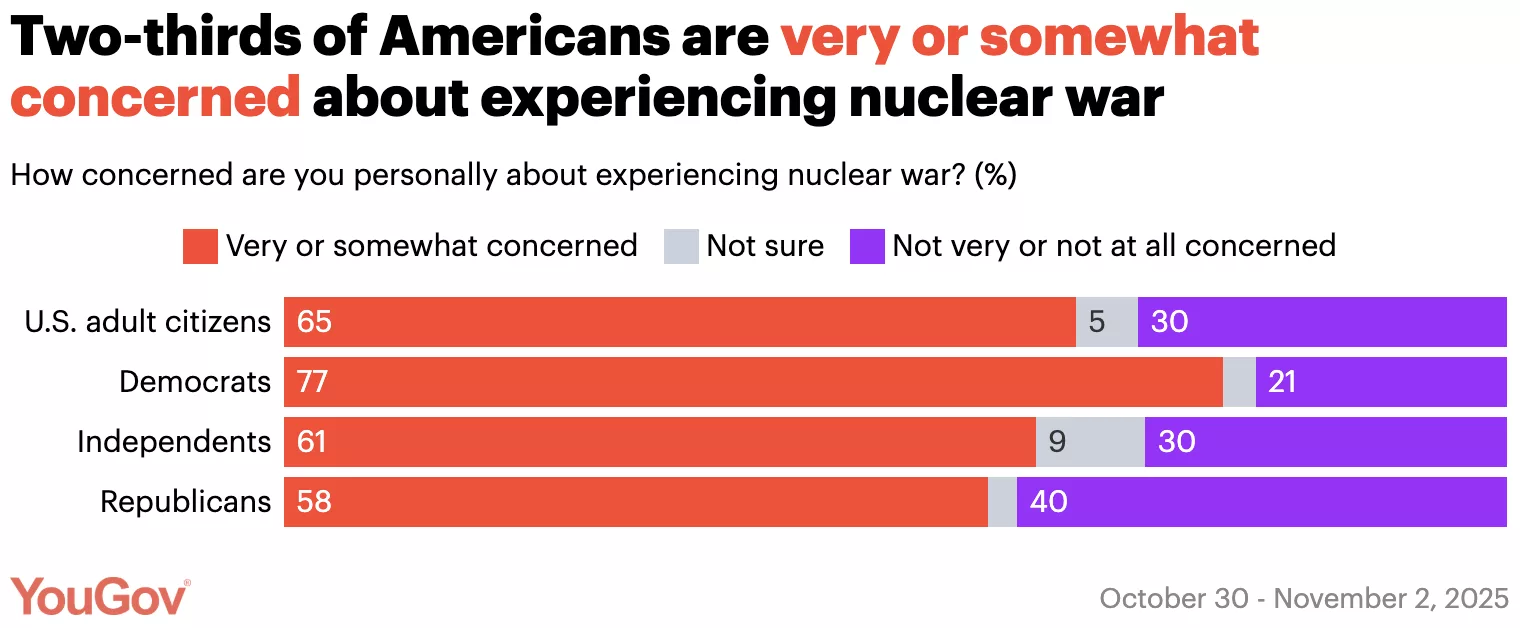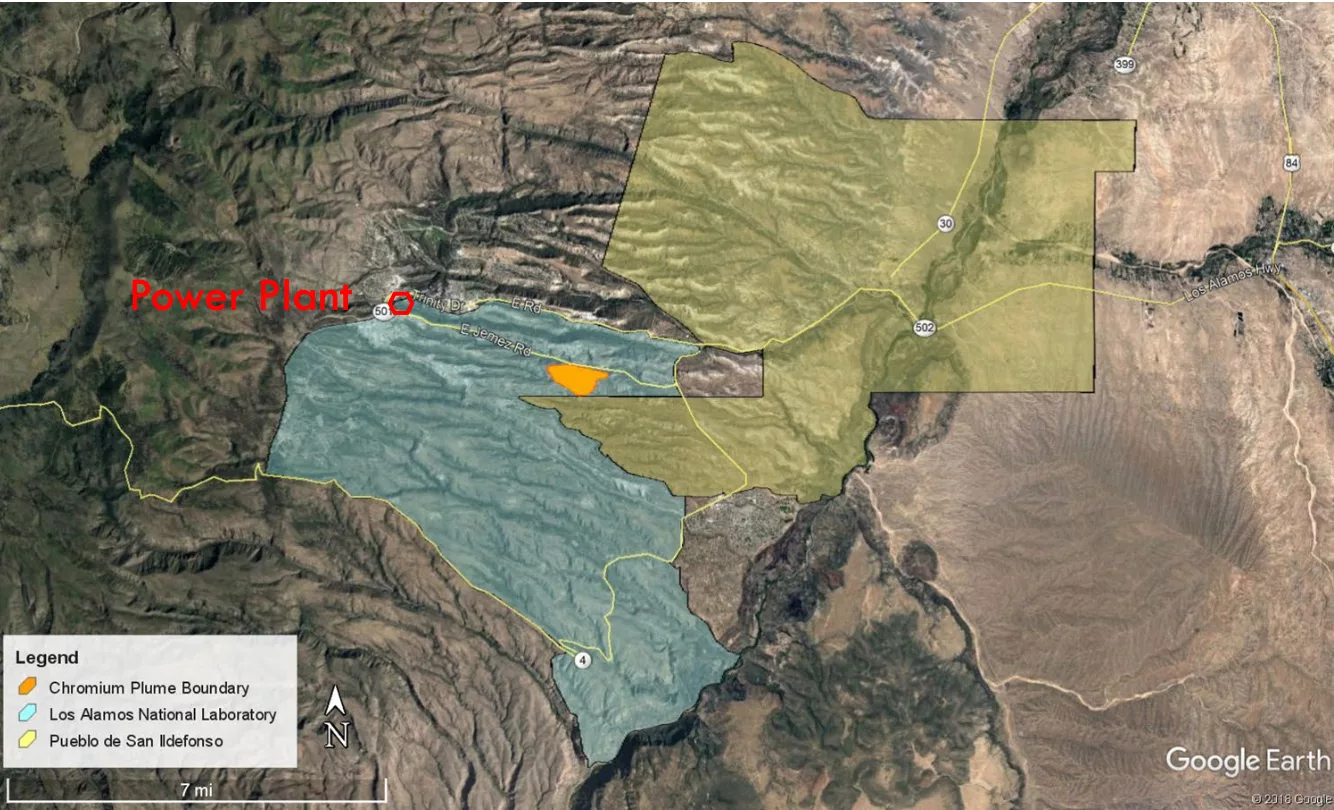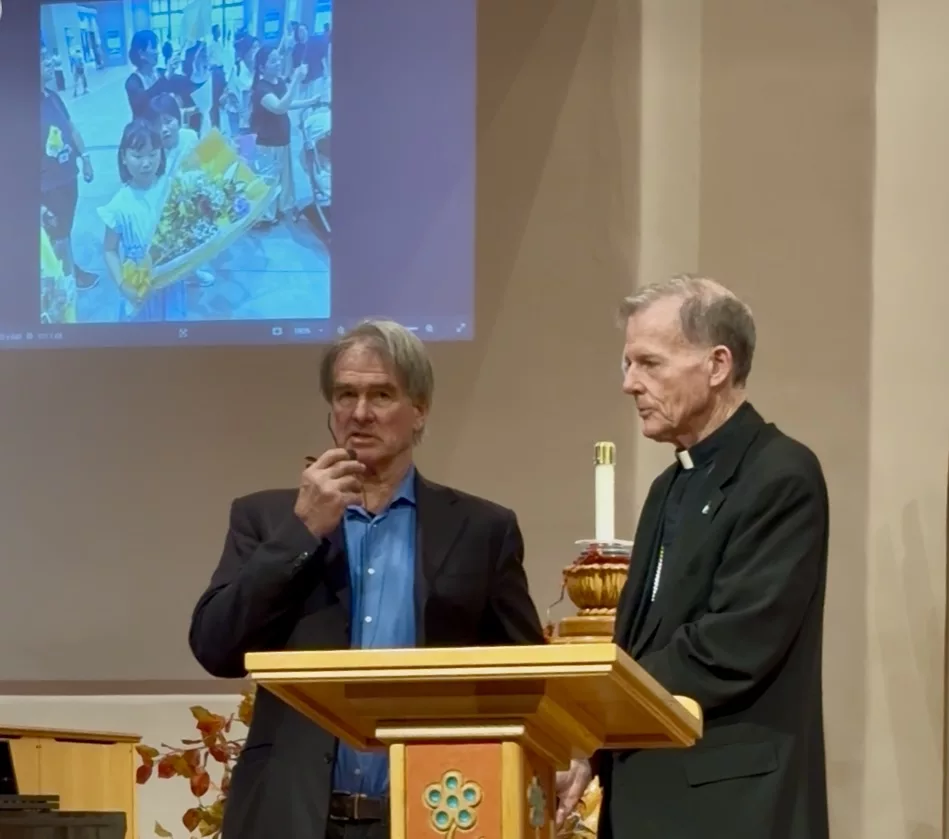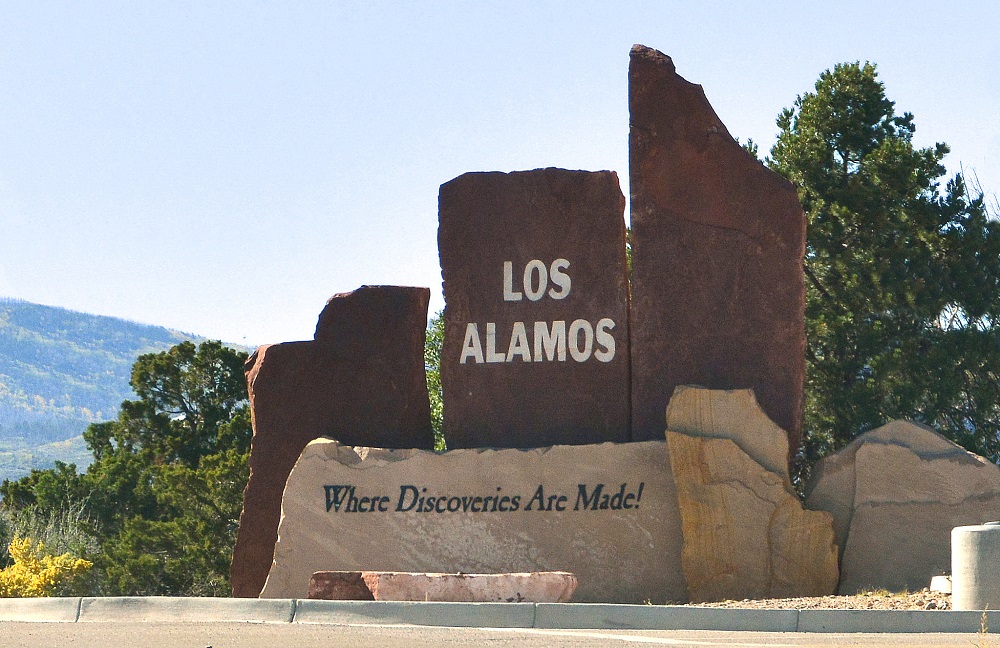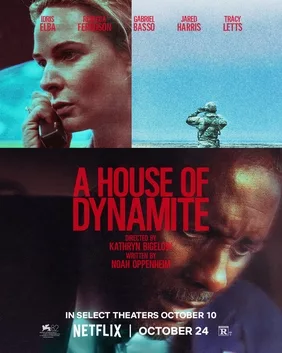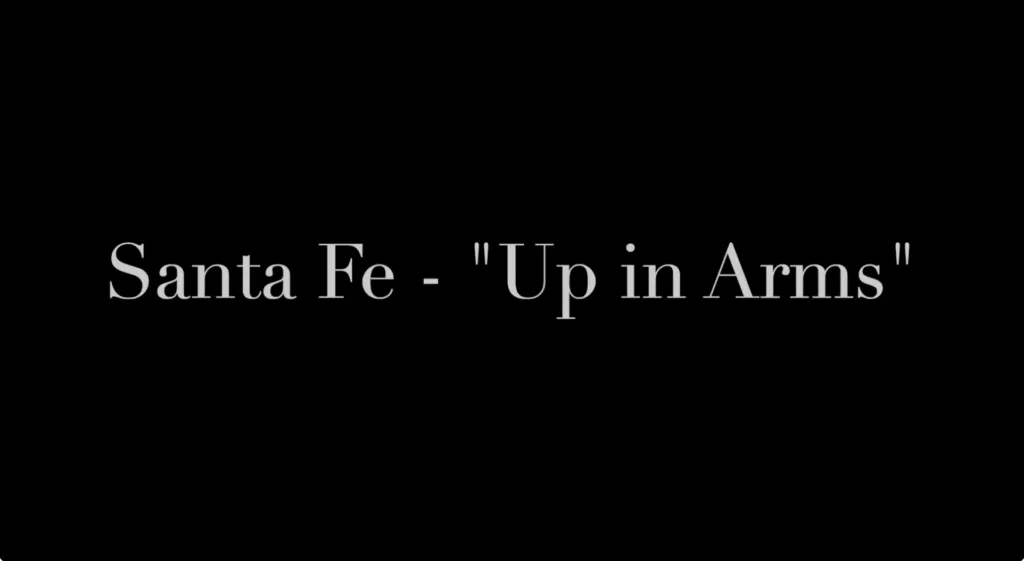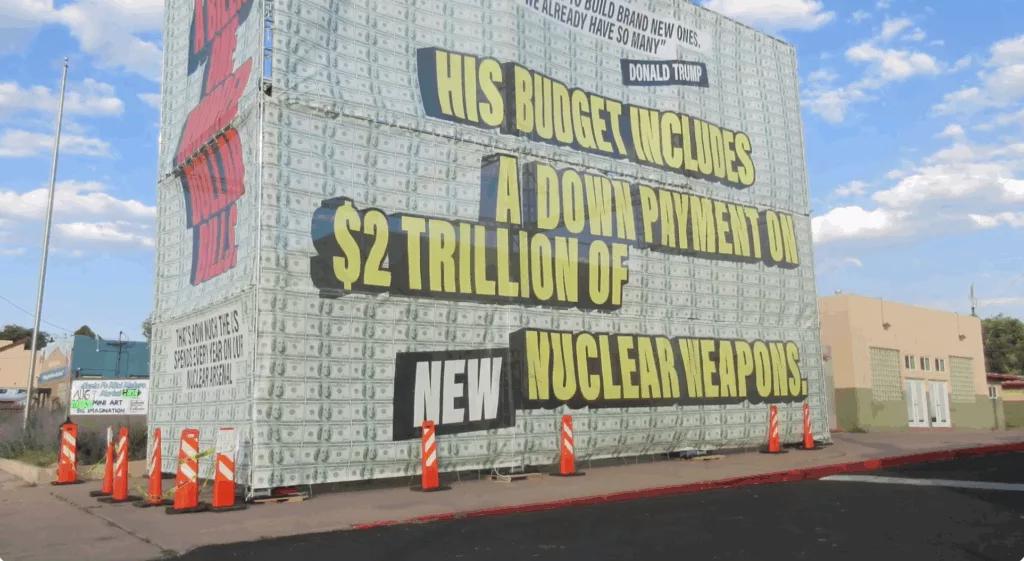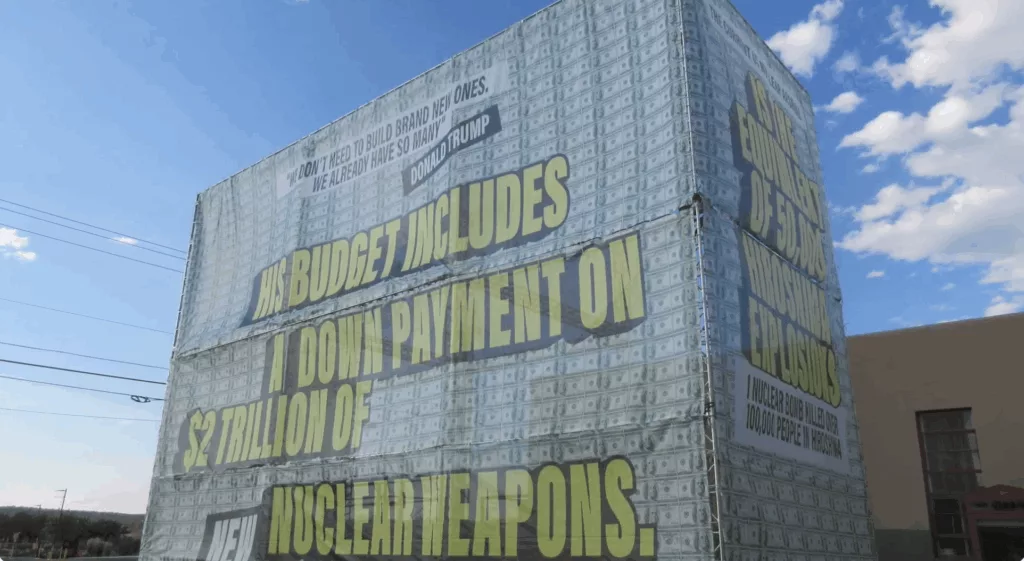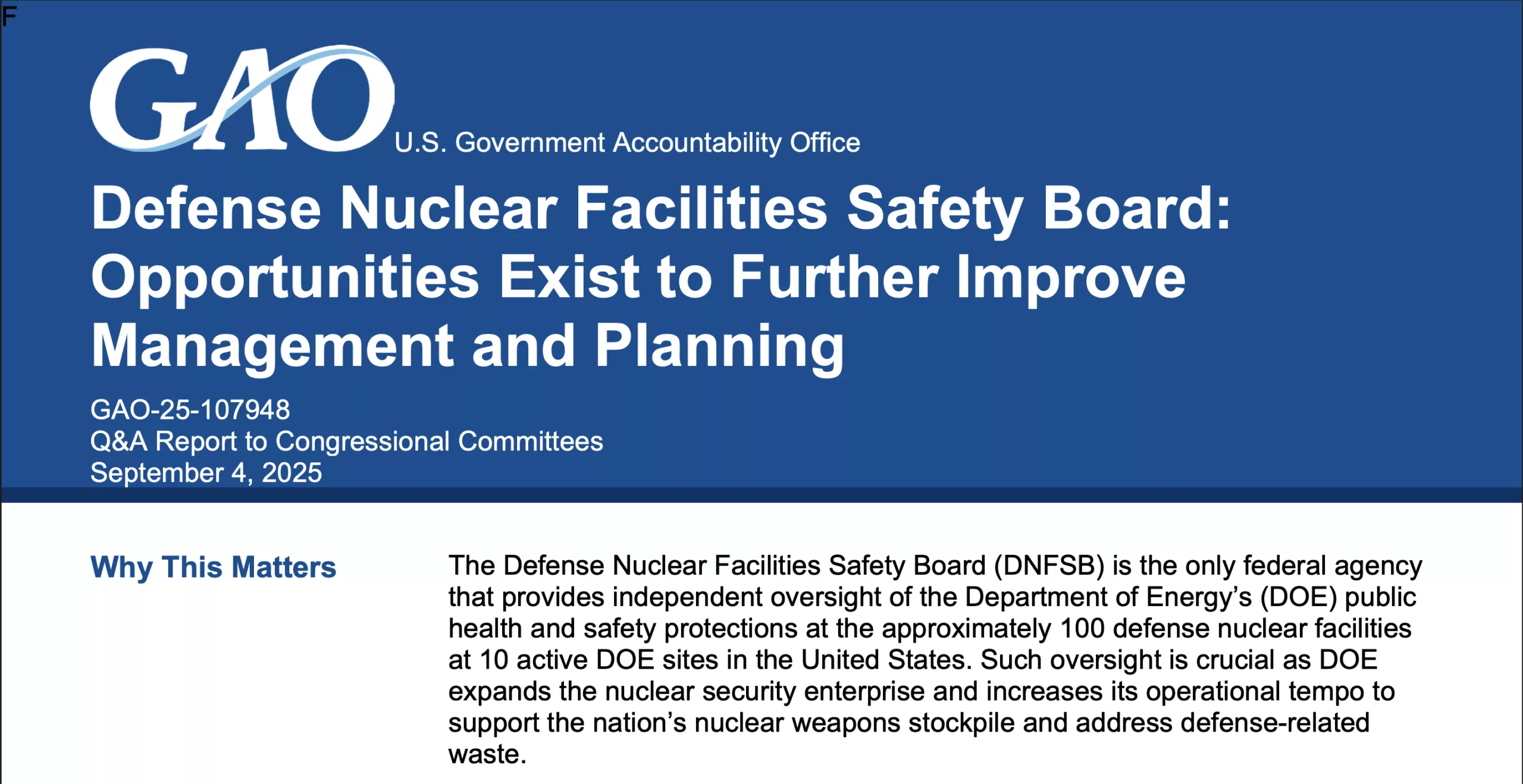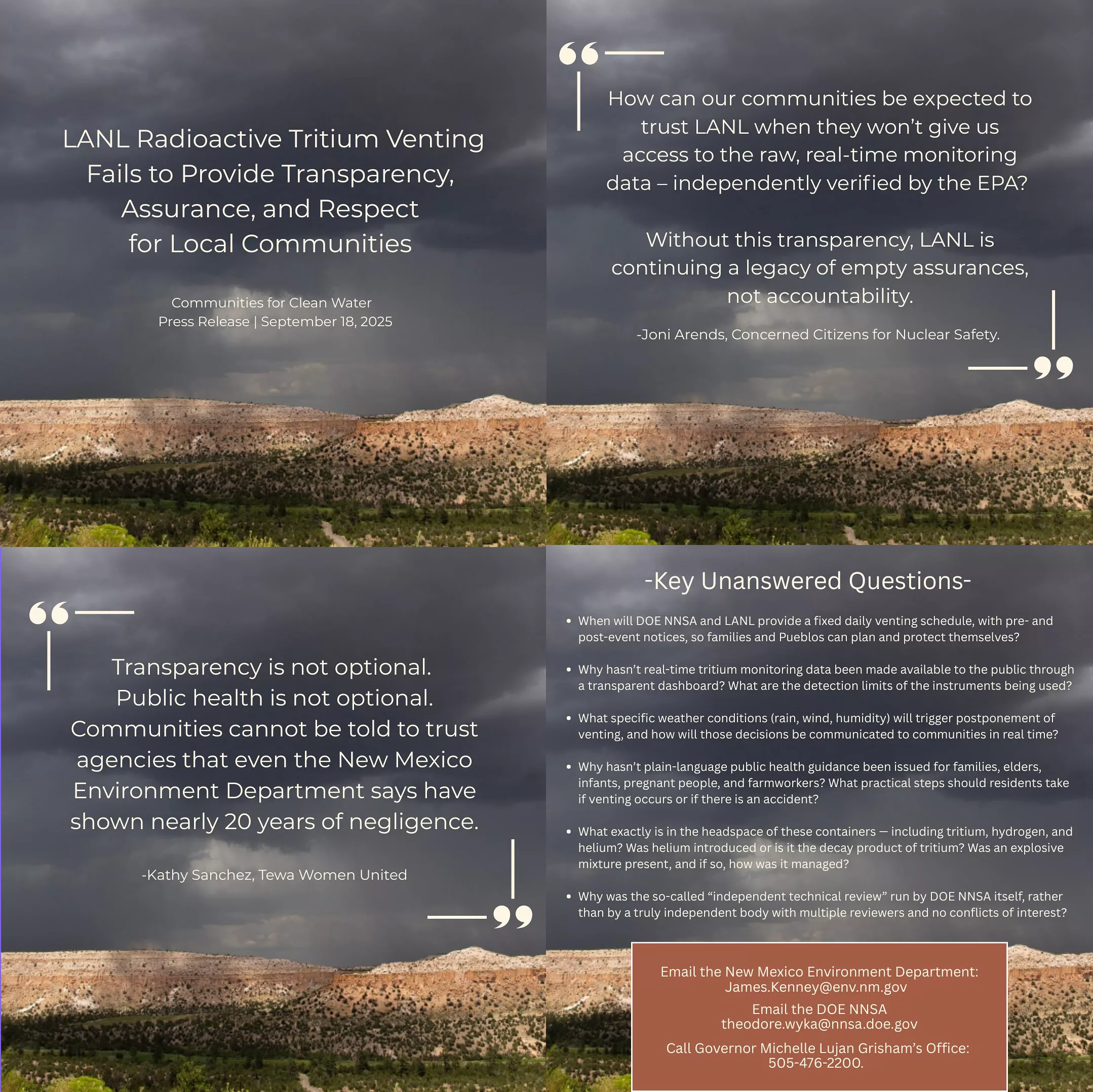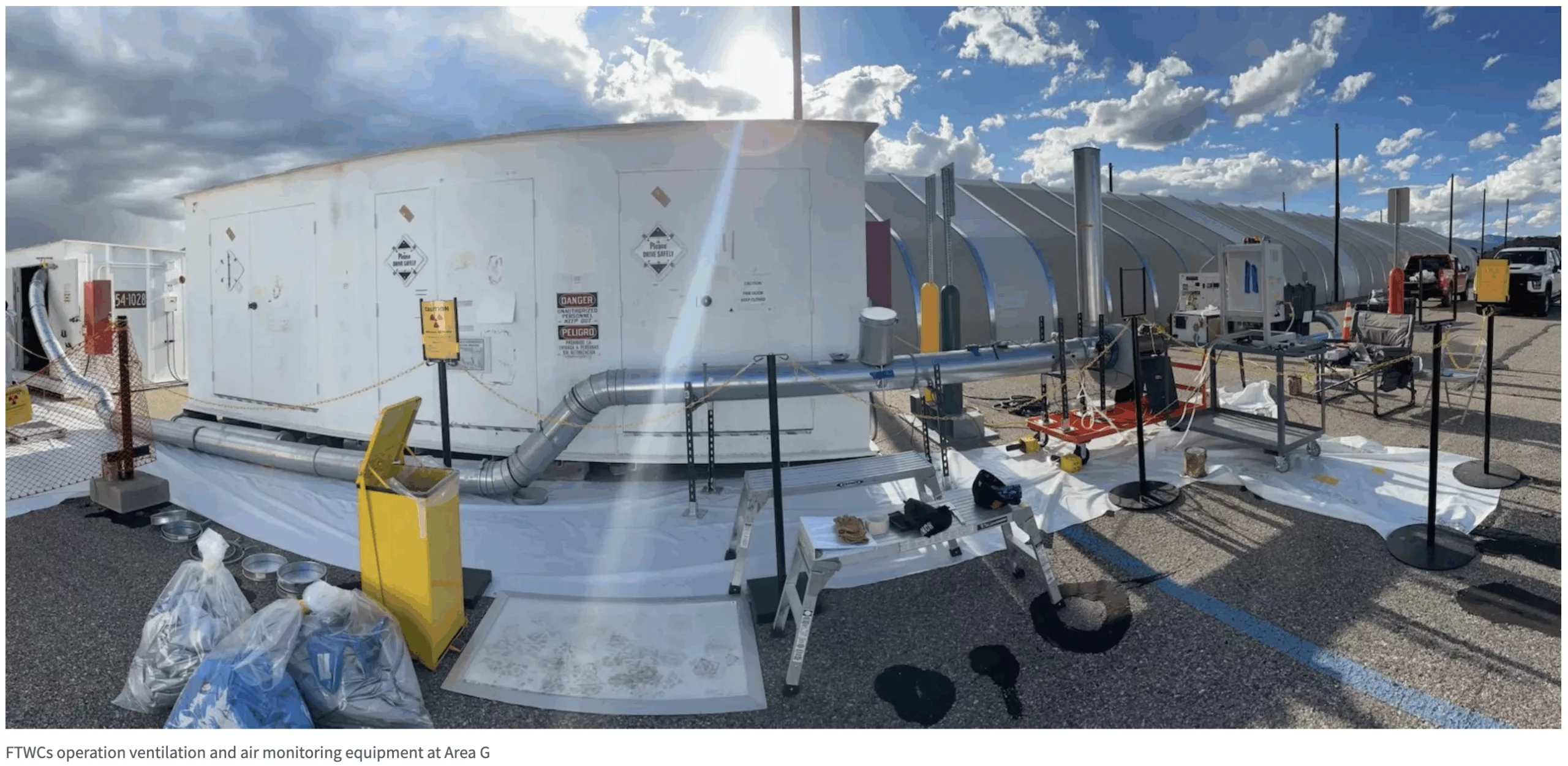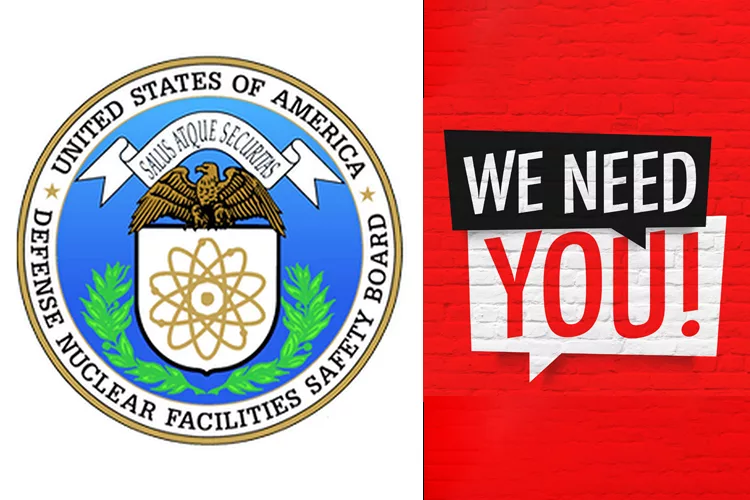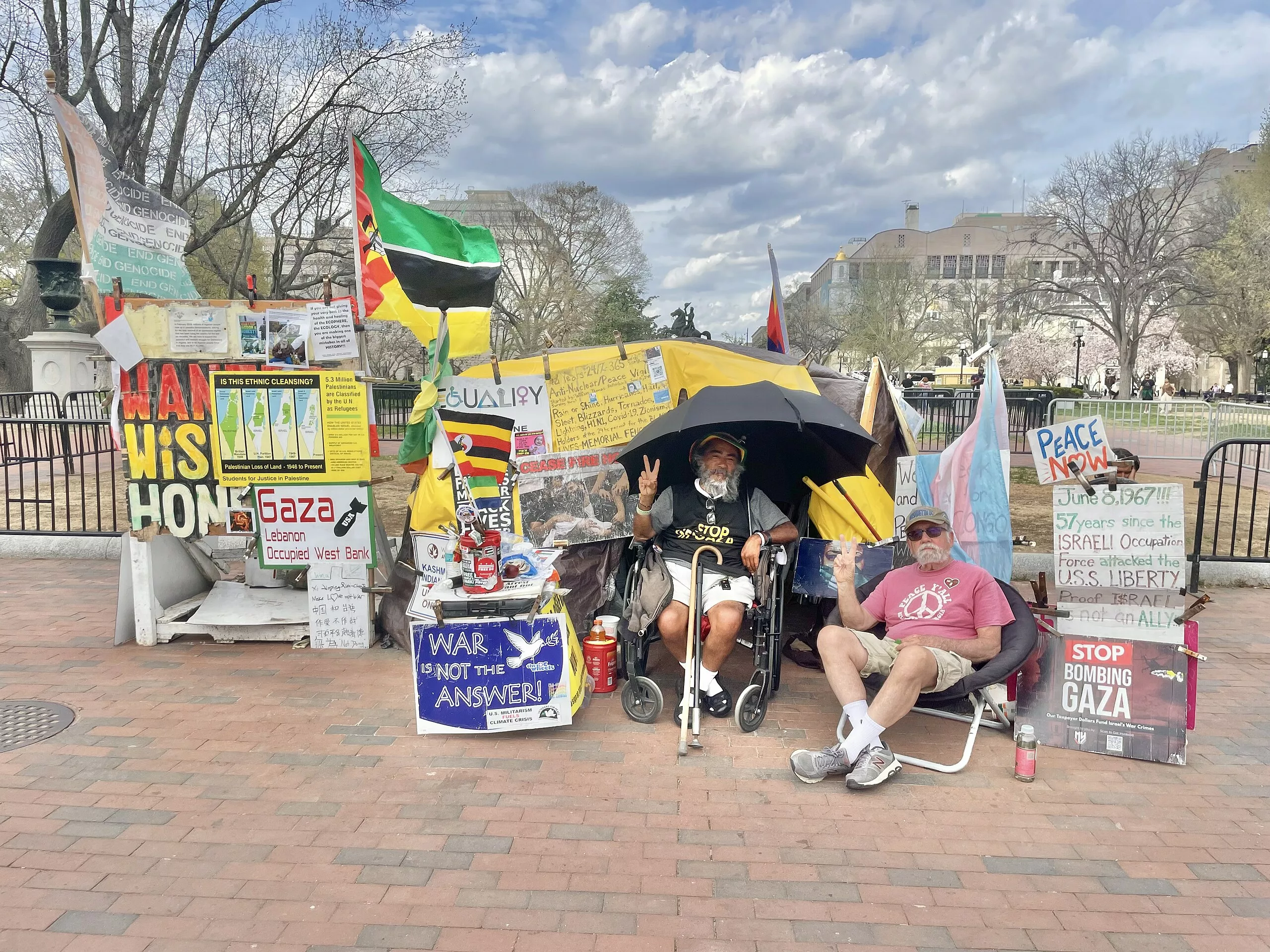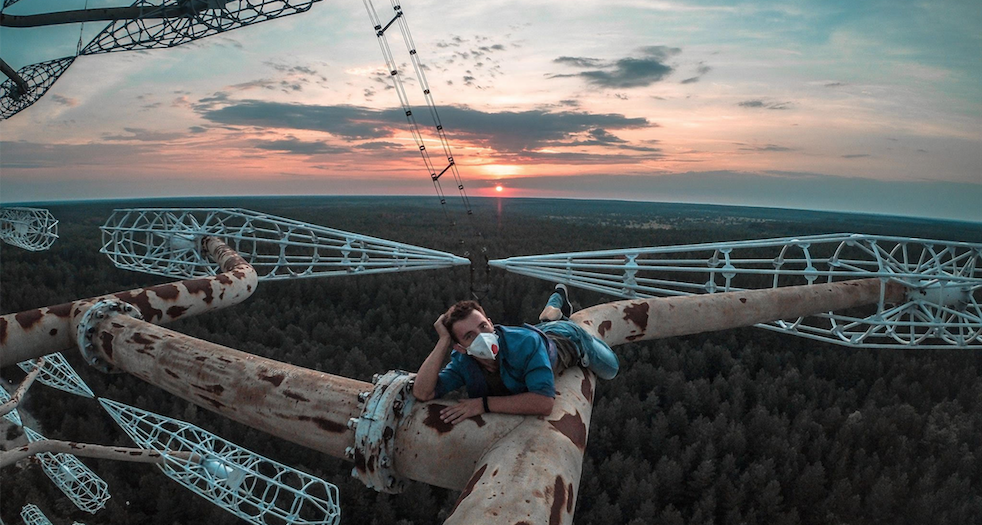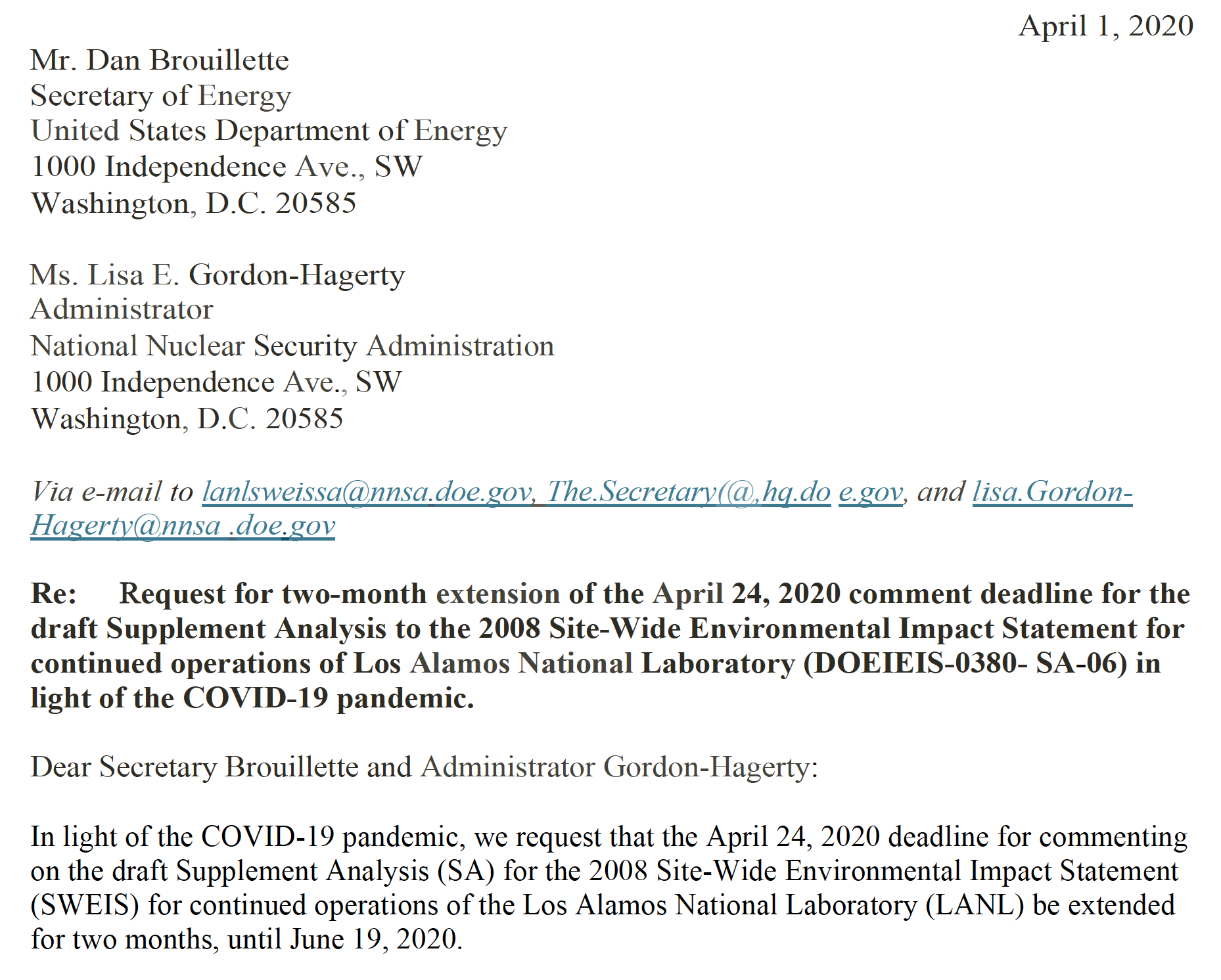Trump talk on nuke testing turns focus to New Mexico’s role in decades of blasts
Jay Coghlan, executive director of the nuclear watchdog group Nuclear Watch New Mexico, said Wright’s comments “somewhat” quelled his initial concerns about a renewed explosive nuclear testing program.
But he said claims Russia and China may be conducting small-scale tests known as hydronuclear tests — banned by the Comprehensive Nuclear Test Ban Treaty, of which the United States, Russia and China are all signatories — continue to give him pause. He fears rumors about the low-yield tests in other nations could be used to justify a domestic return to testing.
“That, in effect, would give permission to the U.S. [to resume testing],” Coghlan said. “But that would be in violation of the norm of the CTBT.”
Three decades removed from the United States’ last nuclear test, a testing regimen would likely be expensive and time-consuming to start up, Coghlan argued, and could prompt other nuclear powers to follow suit.
It seems likely Russia, at least, would: Following Trump’s post, Russian President Vladimir Putin announced if the United States resumed explosive nuclear testing, the Eastern European nation would follow.
“Then everybody else is going to do it, or virtually everybody else will do it, every other nuclear weapons power,” Coghlan said. “I could just see India and Pakistan champing at the bit to test. And then, of course, there’s North Korea and China.”
By Alaina Mencinger amencinger@sfnewmexican.com | November 30, 2025 santafenewmexican.com
It might not have as reverent a name as the Trinity Test or a litany of films made about it. But Project Gnome, a 1961 explosive nuclear test conducted near Carlsbad, is a relic of a bygone era in New Mexico and beyond.
In the 47 years between the Trinity Test and the end of the United States’ explosive nuclear testing in 1992, the nation would perform more than 1,000 such tests — more than any other nuclear nation — with most conducted in Nevada.
New Mexico might not have been the center of the nation’s testing efforts post-Trinity, which marked its 80th anniversary this year, but the state still played a role: Researchers from Sandia National Laboratories and Los Alamos National Laboratory helped design and conduct testing elsewhere, including at the Nevada Test Site and in the Marshall Islands.
Most Democrats and one-third of Republicans think it’s likely the U.S. will get into a nuclear war in the next decade
A new YouGov poll on nuclear weapons finds that nearly half of Americans believe it’s likely the U.S. will get into a nuclear war in the coming decade, and most are worried about personally experiencing a nuclear war. A majority believe nuclear weapons are making the world less safe, but opinions are mixed on whether the U.S. should dismantle all of its nuclear weapons.
By: Jamie Ballard| November 26, 2025 today.yougov.com
46% of Americans think it’s likely the U.S. will get into a nuclear war within the next 10 years; 37% think this is not very or not at all likely. 57% of Democrats and 37% of Republicans think this is likely.
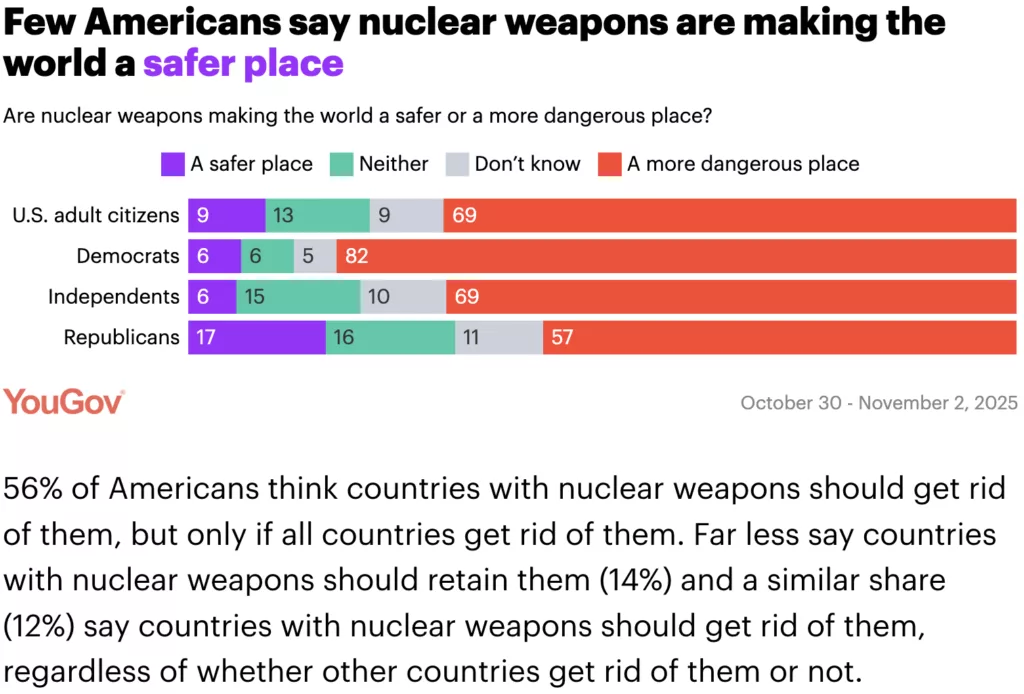
Department of Energy Seeks to Eliminate Radiation Protections Requiring Controls “As Low As Reasonably Achievable”
An internal Department of Energy (DOE) memorandum eliminates worker and public radiation protection rules known “As Low As Reasonably Achievable” (ALARA). This fundamental departure from decades of accepted health physics practices is being promoted by senior DOE political appointees with little background in health or radiation control. It is marked as “URGENCY: High” under the auspices of the DOE Deputy Secretary, the Under Secretary for Science, and the Administrator of the National Nuclear Security Administration. The memorandum awaits the final signature of DOE Secretary Chris Wright.
The memo’s stated goal is to:
“…remove the ALARA principle from all DOE directives and regulations, including DOE Order 458.1, Radiation Protection of the Public and the Environment, NE [Office of Nuclear Energy] Order 458.1, Radiation Protection of the Public, and, upon completion of the rulemaking process, 10 CFR [Code of Federal Regulations] 835, Occupational Radiation Protection.” [1]
It follows the playbook of the Heritage Foundation’s Project 2025, which called for:
“Set[ting] clear radiation exposure and protection standards by eliminating ALARA (“as low as reasonably achievable”) as a regulatory principle and setting clear standards according to radiological risk and dose rather than arbitrary objectives.” [2]
Lab Chromium Contamination Confirmed on San Ildefonso Pueblo Land
Comprehensive Cleanup Needed Instead of More Nuclear Weapons
The New Mexico Environment Department has announced:
“A toxic chromium plume from Los Alamos National Laboratory has spread beyond Lab boundaries onto Pueblo de San Ildefonso land for the first time, with contamination exceeding state groundwater standards… These new results are conclusive evidence that the U.S. Department of Energy’s efforts to contain the chromium plume have been inadequate.”
In reality, chromium groundwater contamination probably migrated beyond the LANL/San Ildefonso Pueblo boundary long ago, with past Lab maps of the plume “magically’ stopping at the border. In the past, tribal leadership has commented that it was fortunate that the contamination stopped there, but that any future indications of groundwater contamination on Pueblo land could have serious consequences. The San Ildefonso Pueblo is a sovereign Native American tribal government.
As late as the late 1990s the Lab was falsely claiming that groundwater contamination was impossible because underlying volcanic tuff is “impermeable.” [1] This ignored the obvious fact that the Parajito Plateau is heavily seismically fractured, providing ready pathways for contaminant migration to deep groundwater. By 2005 even LANL acknowledged that continuing increasing contamination of the regional aquifer is inevitable.[2] Some 300,000 northern New Mexicans rely upon the aquifer for safe drinking water. The potential serious human health effects (including cancer) caused by chromium contamination was the subject of the popular movie Erin Brockovich.
LANL chromium plume spreads onto San Ildefonso Pueblo land, NMED says
Nuclear Watch New Mexico executive direcor Jay Coghlan sees PF-4 as being a bigger scale — and having bigger risks — than the other aging buildings.
“PF-4 is not unique in being old,” Coghlan said. “However, PF-4 is totally unique in currently being the only facility that can process large amounts of plutonium … particularly including plutonium pit production. I think, in part, that’s why the Safety Board focuses more on PF-4 than, to my knowledge, than any other single individual facility.”
By:Patrick Lohmann | November 13, 2025 sourcenm.com
An underground plume of toxic chromium has spread from Los Alamos National Laboratory to Pueblo de San Ildefonso land, state Environment Department officials announced Thursday.
The discovery marks the first time the plume has been detected within the pueblo boundaries, officials said in a news release, though they added the plume’s spread does not pose imminent threats to drinking water in the pueblo or in Los Alamos County. That’s because the plume is not near any known private or public wells, officials said.
Long-term ingestion of hexavalant chromium can cause serious health problems or increase risk of certain cancers.
US Stands Alone Defying UN Vote on Nuclear Test Ban Treaty
Could the LDS Church end an ongoing nuclear weapons project? These veteran activists think so.
By Thalif Deen, Inter Press Sevice | November 12, 2025 ipsnews.net
UNITED NATIONS, Nov 12 2025 (IPS) – The US took another step backward –to break ranks with the United Nations– when it voted against a draft resolution calling for the entry into force of the Comprehensive Nuclear-Test-Ban Treaty (CTBT).
The negative vote followed an announcement by President Trump last month that the US plans to resume nuclear testing after a 33-year hiatus. The US stood alone on the UN vote, which was supported by almost all member States in the General Assembly’s First Committee.
The resolution was adopted by an overwhelming majority: with 168 votes in favor, with one against (United States) and 3 abstentions (India, Mauritius, Syria).
During Trump’s first term, the US abstained on the vote. And in other years they had been voting in favour.
Jackie Cabasso, Executive Director, Western States Legal Foundation, which monitors and analyzes U.S. nuclear weapons programs and policies, told IPS the chaos and uncertainty arose from Trump’s factually-challenged social media post that “because of other countries testing programs, I have instructed the Department of War to start testing our Nuclear Weapons on an equal basis.”
The U.S. government’s first ever “No” vote, on the annual UN resolution in support of the Comprehensive Test Ban Treaty (CTBT), raises further troubling questions about U.S. intentions.
Harking to the MX, Utahns call on LDS Church President Oaks to speak out against nuclear missile being developed in Utah
Could the LDS Church end an ongoing nuclear weapons project? These veteran activists think so.
THE SALT LAKE TRIBUNE | November 9, 2025 sltrib.com
Decades ago, peace activists helped keep a major nuclear weapons system out of Utah with help from key figures, chiefly Spencer W. Kimball, then the president of The Church of Jesus Christ of Latter-day Saints.
Now some of those same individuals are calling on the church’s newly ascended president, Dallin H. Oaks, to follow in his predecessor’s footsteps and speak out against the federal government’s development of a new generation of nuclear missile, known as Sentinel, partly in the Beehive State.
“The arms race continues,” the group of 12 Utahns and one former resident write in a letter mailed to church headquarters in early October, “and a new moral challenge faces” the leaders of the Utah-based faith.
Nuclear Weapons Issues & The Accelerating Arms Race: November 2025
Nuclear weapons:
The government shutdown has impact:
National Nuclear Security Agency confirms 152 furloughed at offices in Albuquerque, Los Alamos
Only 14 employees remain at the two sites By: Danielle Prokop-October 22, 2025
The NNSA confirmed 152 New Mexico employees charged with overseeing national laboratories’ nuclear weapons work were furloughed on Oct. 20, 2025. (Courtesy of NNSA)
The federal government this week sent home more than 150 federal New Mexico employees charged with overseeing national laboratories’ nuclear weapons work, with only 14 employees across two sites remaining at work, the National Nuclear Security Agency confirmed to Source NM.
The furloughs include 71 employees at NNSA’s Los Alamos field office and 81 at the Sandia National Laboratories location, NNSA Deputy Director of Communications Laynee Buckels told Source NM in an email. Seven employees remain at each site, working without pay, she said.
The field offices are responsible for “ensuring compliance with federal contracts to manage and operate the national security assets,” according to the NNSA website
To date there doesn’t appear to be furloughs at LANL, whose employees technically work for a contractor rather than the federal government. Congress is not furloughed, but Speaker Mike Johnson has kept the House out of session. As a result, legislation has come to a screeching halt.
Los Alamos’ plutonium facility safety systems need improvement, oversight board says
Nuclear Watch New Mexico executive direcor Jay Coghlan sees PF-4 as being a bigger scale — and having bigger risks — than the other aging buildings.
“PF-4 is not unique in being old,” Coghlan said. “However, PF-4 is totally unique in currently being the only facility that can process large amounts of plutonium … particularly including plutonium pit production. I think, in part, that’s why the Safety Board focuses more on PF-4 than, to my knowledge, than any other single individual facility.”
By Alaina Mencinger amencinger@sfnewmexican.com | November 7, 2025 santafenewmexican.com
An independent oversight agency wants to see improved safety systems at the facility at the heart of Los Alamos National Laboratory’s plutonium pit mission: PF-4.
The Defense Nuclear Facilities Safety Board reported what it believes to be gaps in a safety analysis drafted for PF-4 and delays in upgrades to safety systems in a letter last month to Energy Secretary Chris Wright.
“Maintaining momentum for these safety infrastructure projects is more important in light of the issues with the safety analysis,” the board wrote in the letter dated Oct. 10. It was signed by former acting chairman Thomas Summers.
LANL Prioritizes Plutonium “Pit” Bomb Core Production Over Safety
The independent Defense Nuclear Facilities Safety Board recently released its Review of the Los Alamos Plutonium Facility Documented Safety Analysis. It concluded that:
“While LANL facility personnel continue to make important upgrades to the Plutonium Facility’s safety systems, many of those projects have encountered delays due to inconsistent funding and other reasons. DOE and LANL should consider prioritizing safety-related infrastructure projects to ensure that the Plutonium Facility safety strategy adequately protects the public, as the facility takes on new and expansive national security missions.” (Page 24)
In early October 2024, the Department of Energy’s semi-autonomous National Nuclear Security Administration (NNSA) announced with great fanfare that the Los Alamos Lab had produced its first “diamond stamped” plutonium pit for the nuclear weapons stockpile. Tens of billions of taxpayers’ dollars have been sunk into LANL’s long delayed and over budget pit production program. Given no further announcements, it is not currently known whether or not the Lab is meeting its congressionally required production goals. Endemic nuclear safety problems have long been an intractable issue, at one point even forcing a three-year halt to plutonium operations at LANL’s Plutonium Facility-4 (“PF-4”).
In its recent Review, the Safety Board reported:
“The [2009] Plutonium Facility safety basis described very large potential [radioactive] dose consequences to the public following seismic events…. DOE committed to upgrade and seismically qualify the ventilation system, with a particular focus on a specific ventilation subsystem…”
“As the only facility in the DOE complex that can process large quantities of plutonium in many forms, [PF-4] represents a unique capability for the nation’s nuclear deterrent. The Board has long advocated for the use of safety-related active confinement systems in nuclear facilities for the purposes of confining radioactive materials…Passive confinement systems are not necessarily capable of containing hazardous materials with confidence because they allow a quantity of unfiltered air contaminated with radioactive material to be released from an operating nuclear facility following certain accident scenarios. Safety related active confinement ventilation systems will continue to function during an accident, thereby ensuring that radioactive material is captured by filters before it can be released into the environment… (Page 2, bolded emphases added)
AP: Trump appears to suggest the US will resume testing nuclear weapons for first time in 30 years
“For Trump, who has cast Russia as a “paper tiger” for failing to swiftly subdue Ukraine, the message is that Russia remains a global military competitor, especially on nuclear weapons, and that Moscow’s overtures on nuclear arms control should be acted on.”
By MICHELLE L. PRICE and CHRIS MEGERIAN | October 30, 2025 apnews.com
BUSAN, South Korea (AP) — President Donald Trump appeared to suggest the U.S. will resume testing nuclear weapons for the first time in three decades, saying it would be on an “equal basis” with Russia and China.
The Kremlin pointed out that a global ban on nuclear tests has remained in place, but warned that if any country resumes nuclear testing Russia would follow suit.
There was no indication the U.S. would start detonating warheads, but Trump offered few details about what seemed to be a significant shift in U.S. policy.
He made the announcement on social media minutes before he met with Chinese leader Xi Jinping on Thursday in South Korea. He offered little clarity when he spoke to reporters later aboard Air Force One as he flew back to Washington.
The U.S. military already regularly tests its missiles that are capable of delivering a nuclear warhead, but it has not detonated the weapons since 1992. The Comprehensive Nuclear Test Ban Treaty, which the U.S. signed but did not ratify, has been observed since its adoption by all countries possessing nuclear weapons, North Korea being the only exception.
REUTERS: Trump tells Pentagon to immediately resume testing US nuclear weapons
“Russia – which tested a new nuclear-powered cruise missile on October 21, held nuclear readiness drills on October 22 and tested a new nuclear-powered autonomous torpedo on October 28 – said it hoped Trump had been properly informed that Moscow had not tested a nuclear weapon itself.”
By Trevor Hunnicutt, Ismail Shakil and Kanishka Singh | October 30, 2025 reuters.com
VIEW THE RECORDING: Santa Fe Ecumenical Conversations Towards Nuclear Disarmament at Santa Maria de la Paz Catholic Community – Monday, October 27
Archbishop John C. Wester and NukeWatch New Mexico presented a special evening at Santa Maria de la Paz Catholic Community on Monday, October 27, from 6:00 to 8:00 p.m. MT. Following a presentation from NukeWatch executive director Jay Coghlan on U.S. nuclear weapons “modernization,” the Archbishop shared reflections from his pastoral letter, Living in the Light of Christ’s Peace, and speak about the importance of dialogue and hope in working toward nuclear disarmament.
View the recording at https://www.youtube.com/watch?v=9LFmQzMoJds&t=1s
Trump Orders Nuclear Weapons Testing for New Nuclear Arms Race
New Plutonium “Pit” Bomb Cores at Los Alamos Lab Could Make It Real
Just minutes before meeting with Chinese President Xi Jinping, Trump posted on his Truth Social media platform that “Because of other countries testing programs, I have instructed the Department of War to start testing our Nuclear Weapons on an equal basis. That process will begin immediately.” House Speaker Mike Johnson soon followed on CNN saying, “I think it is an obvious and logical thing to ensure that our weapons systems work.”
No other countries are currently testing nuclear weapons (the last was by North Korea in 2017). Further, any nuclear weapons tests by the U.S. would be performed by the Department of Energy (whose last test was in 1992), not the Department of War (until recently the Department of Defense). Trump was likely referring to Vladimir Putin’s recent claims of a new nuclear powered cruise missile and a tsunami-causing nuclear-armed torpedo that could threaten America’s coastal cities. In addition, China is dramatically expanding its own fleet of intercontinental ballistic missiles.
But central to all this is the U.S.’ own $2 trillion “modernization” program that will rebuild every nuclear warhead in the planned stockpile with new military capabilities and produce new-design nuclear weapons as well. This so-called modernization program will also build new nuclear weapons production facilities expected to be operational until ~2080, and buy new missiles, subs, and bombers from the usual rich defense contractors, all to keep nuclear weapons forever.
‘Nuclear weapons are blasphemous’: Archbishop Wester continues disarmament push with talk
This event was organized by the “Santa Fe Ecumenical Conversations Towards Nuclear Disarmament” group at the Santa Maria de la Paz parish near the Santa Fe Community College. They kindly invited NukeWatch to speak before Archbishop Wester for what turned out to be a wonderful event. The full recording can be viewed at https://www.youtube.com/@SMDLP/streams
By Cormac Dodd cdodd@sfnewmexican.com | October 28, 2025 santafenewmexican.com
Despite saying he has received a somewhat muted response from the local faithful, Santa Fe’s Catholic archbishop is still pushing nuclear disarmament as vital to humanity’s spiritual well-being and continued existence.
“I think nuclear weapons are blasphemous, because I think nuclear weapons are humanity’s attempt to build a Tower of Babel, an attempt to eat from the apple of the tree of the Garden of Eden, to become like God, to become gods,” Archbishop John C. Wester said in a roughly 30-minute address at Santa Maria de la Paz Catholic Church south of Santa Fe.
“In humility, we must avoid inventing anything that, in a matter of hours, can destroy what God has created,” the leader of the Archdiocese of Santa Fe continued. “The story of Adam and Eve is archetypal, I think: When human beings try to become as God, they lose the Garden of Eden and they must endure the cruel reality of paradise lost.”
The archbishop’s comments followed a journey he undertook to Japan on the 80th anniversary of the U.S. military’s decision to drop atomic bombs on Hiroshima and Nagasaki toward the end of World War II. He spoke in front of an audience of about 50 people — who gave Wester a standing ovation — at Monday’s event
In a Looming Nuclear Arms Race, Aging Los Alamos Faces a Major Test
The lab where Oppenheimer developed the atomic bomb is the linchpin in the United States’ effort to modernize its nuclear weapons. Yet the site has contended with contamination incidents, work disruptions and old infrastructure.
By Alicia Inez Guzmán | October 28, 2025 The New York Times nytimes.com
In a sprawling building atop a mesa in New Mexico, workers labor around the clock to fulfill a vital mission: producing America’s nuclear bomb cores.
The effort is uniquely challenging. Technicians at Los Alamos National Laboratory must handle hazardous plutonium to create the grapefruit-size cores, known as pits. They do so in a nearly 50-year-old building under renovation to address aging infrastructure and equipment breakdowns that have at times disrupted operations or spread radioactive contamination, The New York Times found.
Now, the laboratory is under increasing pressure to meet the federal government’s ambitions to upgrade the nation’s nuclear arsenal. The $1.7 trillion project includes everything from revitalizing missile silos burrowed deep in five states, to producing new warheads that contain the pits, to arming new land-based missiles, bomber jets and submarines.
But the overall modernization effort is years behind schedule, with costs ballooning by the billions, according to the Congressional Budget Office. In 2018, Congress charged Los Alamos with making an annual quota of 30 pits by 2026, but by last year it had produced just one approved for the nuclear stockpile. (Officials have not disclosed whether more have been made since then.)
*The featured image differs from the article photo due to usage rights.
Why Putin’s ‘invincible’ nuclear-powered missile is more likely to become a disastrous ‘flying Chernobyl’ for Russia
The US abandoned efforts to build nuclear-powered missile weapons during the 1950s arms race with the Soviet Union as a nuclear-powered missile would effectively be a huge radiation risk.
Jeffrey Lewis, a nuclear nonproliferation expert at Middlebury College, described it as a “tiny flying Chernobyl,” referencing the Soviet power plant that melted down and covered a 1,600-mile area with toxic radiation…While Lewis believes the Burevestnik is only capable of subsonic speed and easy to intercept, he warned that Russia’s ambition poses a return to the Cold War era.
“NATO aircraft could intercept it. The problem is that Burevestnik is yet another step in an arms race that offers no victory for either side,” he wrote on X.
By Ronny Reyes | October 28, 2025 nypost.com
Russian strongman Vladimir Putin’s latest threats that Moscow is preparing to deploy its new “invincible” nuclear-powered cruise missile has drawn a rebuke from President Trump and a reminder of America’s own nuclear might.
But experts say the Burevestnik missile could end up being more like a disastrous “flying Chernobyl” for Russia — and proves Putin is actually nervous about the possibility of the US giving Tomahawk cruise missiles to Ukraine.
George Barros, of the Washington-based Institute for the Study of War, described Putin’s ominous Sunday announcement as a form of fear mongering from a Kremlin afraid that the US could give Kyiv a much more conventional weapon — the tried and true Tomahawk.
Russia tested new nuclear-powered Burevestnik cruise missile
“For Trump, who has cast Russia as a “paper tiger” for failing to swiftly subdue Ukraine, the message is that Russia remains a global military competitor, especially on nuclear weapons, and that Moscow’s overtures on nuclear arms control should be acted on.”
By Guy Faulconbridge and Lidia Kelly Tim Balk | October 26, 2025 reuters.com
- Russia tests nuclear-capable Burevestnik missile
- Missile flew for 14,000 km, 15 hours
- Putin says it can pierce any missile defences
Trump Administration Providing Weapons Grade Plutonium to Sam Altman
“If there were adults in the room and I could trust the federal government to impose the right standards, it wouldn’t be such a great concern, but it just doesn’t seem feasible.”
By: Joe Wilkins | October 24, 2025 futurism.com
With the economy the way it is these days, it’s nice to have a little walking around money.
Donald Trump certainly thinks so. Since his return to the White House, the president has labeled 440 federal properties for possible sale, leased 13.1 million acres of public land for strip mining, and held a fire sale for satellites developed by NASA’s Jet Propulsion Lab.
In one of his wildest money moves to date, the Financial Times reports that Trump is now offering companies access to plutonium from America’s arsenal of cold war nuclear missiles.
On Tuesday, the US Department of Energy (DOE) launched an application for interested parties to apply for access to a maximum of 19 metric tonnes — a little under 42,000 pounds — of weapons-grade plutonium, which has long been a key resource undergirding the US nuclear arsenal.
One of the companies anticipated to receive shipments of the fissile isotope from the DOE is Oklo, a “nuclear startup” backed — and formerly chaired — by OpenAI CEO Sam Altman. Earlier in October, Oklo was one of four US companies chosen by the DOE to join a new pilot program meant to rush the testing and approval of experimental reactor designs.
As the FT reports, we won’t know for certain until December 31, when the DOE announces the companies selected to purchase the plutonium, but it’s likely Oklo will be among them. That’s stirring up plenty of anxiety throughout the scientific community, who say the relaxed approach to nuclear development is a major cause for alarm.
“If there were adults in the room and I could trust the federal government to impose the right standards, it wouldn’t be such a great concern, but it just doesn’t seem feasible,” Edwin Lyman, a physicist with the Union of Concerned Scientists told the FT.
U.S. Agency That Protects Nuclear Arsenal to Furlough Workers
Jay Coghlan, the executive director of Nuclear Watch New Mexico, a private group that monitors the agency, said it was unclear if the furloughs would have any immediate effect on nuclear safety. “As a baseline, the nuclear safety officers have always been understaffed. There is simply not enough federal oversight as is. And then you’re talking about furloughing more,” he added.
By Tim Balk | October 17, 2025 nytimes.com
![]() The National Nuclear Security Administration said 1,400 workers would be affected by Monday.
The National Nuclear Security Administration said 1,400 workers would be affected by Monday.
Nuclear weapons safety oversight in decline with Trump, Biden inaction
The lone independent federal agency responsible for ensuring safety at U.S. nuclear weapons sites — including Hanford in Washington state — will lose its ability to issue recommendations for safer work by January if the Trump administration doesn’t replenish its board, which this month dwindles to one member.
By Patrick Malone | October 15, 2025 seattletimes.com
The Defense Nuclear Facilities Safety Board ensures adequate public health and worker safety by scrutinizing hazardous work conducted by the U.S. Department of Energy and its contractors that produce and maintain the nuclear arsenal. If the Trump administration and Congress don’t move quickly to populate the board, it will be incapable of issuing formal safety recommendations to the Energy Department, according to a report last month from the Government Accountability Office, Congress’ investigative arm.
If the board is without a quorum of at least three members for a year, “the agency would essentially be able to offer only nonbinding advice to DOE,” according to the report.
“The whole idea of having the board in place is to provide the optics in addition to the substance,” Nathan Anderson, a Washington state-based director in the GAO’s natural resources division, told The Seattle Times.
The board does not have regulatory or enforcement authorities, but its advice carries significant weight and cannot be easily dismissed or disregarded, the GAO report states. The board’s recommendations to the U.S. secretary of energy are published for public comment, and the secretary must respond in writing. The board also reports each year to selected congressional committees on its recommendations to the Energy Department and any outstanding safety problems.
FULL ORIGINAL ARTICLE (SEATTLE TIMES)
YOU CAN HELP SAVE THE DNFSB TODAY:
Continue reading
New Article about “Participatory Democracy in Action” Describes WIPP Permit Negotiations
Thanks to our friends at Concerned Citizens for Nuclear Safety for this article:
In an essay for NYU’s Democracy Project, David F. Levi, a former federal judge and director emeritus of the Bolch Judicial Institute at Duke Law, reflected on the negotiations he facilitated in New Mexico about the renewal of the hazardous waste permit for the Waste Isolation Pilot Plant (WIPP), a deep geologic repository for plutonium-contaminated waste generated in the fabrication of nuclear weapons. Judge Levi’s essay is entitled “Participatory Democracy in Action.” He wrote:
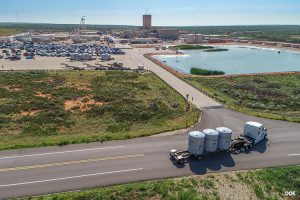 “A couple of years ago, I was asked to mediate a dispute between the U.S. Department of Energy (DOE) and the New Mexico Environment Department (NMED) concerning the renewal of a required state permit for DOE’s Waste Isolation Pilot Plant (WIPP), the nation’s only deep underground nuclear waste storage facility, located outside of Carlsbad, New Mexico. I thought I could help the two government entities but quickly came to realize that under the mediation procedures followed by New Mexico, the mediation would also involve citizen groups whose ultimate concurrence was essential to any complete resolution. This was entirely new to me.
“A couple of years ago, I was asked to mediate a dispute between the U.S. Department of Energy (DOE) and the New Mexico Environment Department (NMED) concerning the renewal of a required state permit for DOE’s Waste Isolation Pilot Plant (WIPP), the nation’s only deep underground nuclear waste storage facility, located outside of Carlsbad, New Mexico. I thought I could help the two government entities but quickly came to realize that under the mediation procedures followed by New Mexico, the mediation would also involve citizen groups whose ultimate concurrence was essential to any complete resolution. This was entirely new to me.
“In this case, there were seven such citizen groups entitled to participate and representing a variety of points of view. There was one group representing some of the government and business leaders of the town of Carlsbad who favored permit renewal on terms ensuring the continued long-term operation of WIPP. There were six groups expressing a variety of concerns about nuclear waste coming to New Mexico. They sought a more restrictive permit.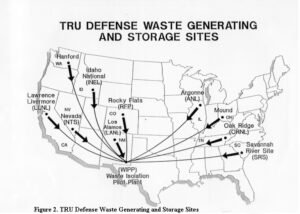
“To my astonishment, over the course of four full days, we worked through the multitude of issues and came to complete agreement. Something magical had happened. Thanks to the goodwill of the DOE and its contractor, the remarkable daily attendance and attentiveness of the NMED Secretary and the measured and well-informed way in which the various citizen groups made their points, we were able to find consensus and craft permit language that was acceptable to everyone.
“For me, as a former judge and mediator, the experience was thrilling. It was an experience of participatory democracy in action that made me proud of our fellow citizens and our government. Three aspects of the experience stand out. First, everyone in the room had taken responsibility for the way in which our nation’s only deep underground nuclear storage facility would be operated for the next 10 years. The citizen participants were not just making suggestions; they were assuming many of the attributes of decision makers. Second, all participants were advocating, compromising, and collaborating on behalf of what they saw as the public interest. These are the essential skills of democracy—the civic virtues so central to the Founders’ vision of what would make democracy work in America—and they require practice. Finally, over four days around a table, the citizens were able to take the measure of the DOE and NMED representatives. They came to realize, as I did, that these public servants, as well as the DOE contractor, were very well-informed, experienced, and intentioned. The government representatives had a similar experience of coming to appreciate the citizen questions and points of view. A government that relies on trust needs this kind of interaction to maintain that trust.
“It seems our democracy would be strengthened if we could extend the benefits of this kind of participatory structure to other areas of our legal and regulatory systems.”
“In Democracy in America, Alexis de Tocqueville made some of these points in reference to the jury trial in civil cases. He emphasized the importance of the civil jury trial as a free “public school” [https://contextus.org/Tocqueville,_Democracy_in_America_(1835),_Book_I,_Chapter_XVI_Causes_Mitigating_Tyranny_In_The_United_States_(Part_II).13?ven=Gutenberg&lang=en]  educating jurors in the democratic virtues and skills and teaching them to assume responsibility. In the same vein, every trial judge I know would attest to the importance of the jury experience for building confidence in the courts. After a trial, judges often hear words of gratitude from jurors who are deeply impressed by the legal process and are honored to have participated despite their initial dismay at being called to jury service. Sadly, the number of jury trials has diminished, particularly in federal court. Reversing that trend is a worthy goal, particularly for a branch of government that depends so heavily on public confidence.
educating jurors in the democratic virtues and skills and teaching them to assume responsibility. In the same vein, every trial judge I know would attest to the importance of the jury experience for building confidence in the courts. After a trial, judges often hear words of gratitude from jurors who are deeply impressed by the legal process and are honored to have participated despite their initial dismay at being called to jury service. Sadly, the number of jury trials has diminished, particularly in federal court. Reversing that trend is a worthy goal, particularly for a branch of government that depends so heavily on public confidence.
“As a final reflection: any persons involved as litigants will have an experience of the legal system. The experience can advance their sense of agency and participation, their ability to disagree civilly, and their trust in the courts. But how can these objectives be obtained when so many Americans cannot afford a lawyer? We can do so much better to provide understanding of and access to our justice system.”
The six New Mexico based non-governmental organizations were Citizens for Alternatives to Radioactive Dumping (CARD), Concerned Citizens for Nuclear Safety (CCNS), Conservation Voters New Mexico (CVNM), Nuclear Watch New Mexico, Southwest Alliance for a Safe Future (SAFE), and Southwest Research and Information Center (SRIC). The individual was Steve Zappe, a grandfather and former NMED WIPP Program Manager.
“A House of Dynamite” New Netflix Nuclear Catastrophe Film: Fiction, for Now
The reviews are rolling in for “A House of Dynamite,” which premiered in Europe earlier this month before coming to the U.S. on October 10th, with a full Netflix release scheduled for the 24th. Here’s the trailer, and see the schedule for Santa Fe theater showings here:
This Week! Santa Fe Theater Screenings for the Film “A House of Dynamite”
I attended one of these screenings last night, and I’ll let the professional critic reviews give the gist:
The Kathryn Bigelow thriller looks at what might happen if a ballistic missile were headed to the U.S. The director hopes the movie will start a conversation. New York Times: At Venice, ‘A House of Dynamite’ Is Scarier Than Most Horror Films
“The Netflix thriller captures from multiple perspectives the White House response to an unattributed missile launch headed for a major U.S. city in the harrowing 20 minutes until projected impact…”An unrelenting chokehold thriller so controlled, kinetic and unsettlingly immersive that you stagger out at the end of it wondering if the world will still be intact.” ‘A House of Dynamite’ Review: Idris Elba and Rebecca Ferguson in Kathryn Bigelow’s Precision-Tooled, Viscerally Unsettling Nail-Biter
“Told from the perspective of soldiers at a remote Alaskan missile base, staffers in the White House situation room, military officials at US Central Command (CENTCOM), and the president of the United States, the film weaves an overlapping timeline to show how the United States would respond to a missile attack…The film doesn’t want viewers to ask themselves how to thwart a nuclear attack on the United States. Rather, it wants the viewer to question the value of having nuclear weapons at all. ‘None of this makes sense,’ the President (Idris Elba) bemoans, ‘Making all these bombs and all these plans.'”
“A House of Dynamite is a terrifying examination of how terribly wrong things can go even with highly competent people in charge…But that’s also not necessarily the world we’re living in…The film shows why the worst can happen, even when competent, well-meaning people are trying to do the right thing.
But what if competence and decency are in short supply?” A House of Dynamite: Bigelow’s latest thriller shows why nuclear bombs are only part of the danger
This film left me reeling with tension and anxiety and exactly as the Times article titles it, is scarier than most horror films. Unlike ‘Oppenheimer,’ which largely glorified the invention of the atomic weapon, ‘A House of Dynamite’ makes it impossible to ignore the threat that nuclear weapons pose to our world. Working backwards from perspectives, and focused on how we can actually improve our odds of keeping this story a fictional one, here is what struck me most about this film:
-
-
Only one person decides what happens. But the real threat isn’t one reckless leader — it’s a reckless system. The final segment of the film features the “nuclear football” heavily, a briefcase containing launch procedures and options. In the United States, the president holds the sole and absolute authority to order the use of nuclear weapons. In the film, there are many voices in the President’s ear, but two primary perspectives quickly emerge after the defense fails and the ICBM remains inbound to its U.S. target: “One side advocates a retaliatory strike; the other, nothing. ‘It’s surrender or suicide,’ one adviser tells the President,” – thebulletin.org. The military aide carrying the nuclear football is tasked with providing the President the list of options if retaliation is chosen. An absolute must-read, Daniel Ellsberg’s book “The Doomsday Machine” breaks down many of the themes in the film with pure and terrifyingly honest account of Cold War-era nuclear strategy. In terms of launch authority, he describes how the inherent instability of the delegated command structure of the nuclear apparatus makes accidental or unwanted war an ever-present danger.
-
LANL tritium containers to head to Texas after last treatment
Four flanged tritium waste containers have been depressurized and transported to Los Alamos National Laboratory’s Weapons Engineering Tritium Facility, where they will be treated further before heading out-of-state for disposal.
By Alaina Mencinger amencinger@sfnewmexican.com | October 15, 2025 santafenewmexican.com
The containers’ final destination is Waste Control Specialists, a West Texas facility that handles the storage and disposal of radioactive waste.
The more than 1,300-acre facility in Andrews County is located on an approximately 14,000 acre property, which is sited on a thick clay formation which the company describes as “nearly impermeable.”
New documents have been added to the Los Alamos Legacy Cleanup Contract Electronic Public Reading Room.
All legacy cleanup documents required to be posted after April 30, 2018, are available on the site linked above.
For legacy cleanup documents that were posted prior to April 30, 2018, please visit the LANL electronic public reading room.
- Review, Notice of Completion of Off-Site Waste Shipments for Final Disposal, Activities 3.1.5, 3.1.8, and 3.3.4, Compliance Plan, Site Treatment Plan, Federal Facility Compliance Order Los Alamos National Laboratory [July 31, Aug. 21, 2025]
https://ext.em-la.doe.gov/GovFTPFiles/api/GetFiles/GetFile?fileName=EMID-703933_NMED_Review_STP_Shpmt_Jul_31_Aug_21_101525.pdf
Strong Political and Public Opposition Means Consolidated Interim Storage Facility (CISF) in NM “Impossible in the Near Future”
NEW UPDATE OCTOBER 10, 2025:
Holtec abandons plan to build New Mexico storage facility for spent nuclear fuel
This is excellent news. The Governor and state legislature (specifically Senator Jeff Steinborn and Representative McQueen) are to be commended for not allowing New Mexico to become the nation’s dumping ground for highly radioactive commercial spent fuel rods, especially when the Land of Enchantment has never had its own nuclear energy plant. Hard work from many New Mexicans made this happen.
So-called “interim” storage would never be interim when the federal government has failed for more than four decades to find a permanent repository for these lethal wastes. This also shows how hollow all the hype is about the claimed renaissance of nuclear power, when on the front end the industry can’t survive without taxpayer handouts, and on the back end can’t solve its radioactive waste problem.
Holtec’s quote that “New Mexico’s acquiescence is necessary” for interim storage to go forward is interesting, implying that we have to surrender as the nuclear colony that we are. Well, guess what, we didn’t surrender, and I predict you’ll see more of this. Moreover, whether you’re pro-nuclear or anti-nuclear, Holtec is an ethically questionable company, which is why the attorneys general of New Jersey and Massachusetts have sued it.
Adiós and good riddance, Holtec!
New York Times: Tax Break Scandal Leads to $5 Million Fine for N.J. Energy Company
SEE MORE:
Nuclear Weapons Issues & The Accelerating Arms Race: September 2025
Nuclear Weapons Update:
Putin has offered Trump a one-year extension of the numerical cap on strategic nuclear weapons in the new Strategic Arms Reduction Treaty which is 1,550 warheads (however, B52s are counted as one warhead while they can carry a dozen). New START expires in February 2026, which will be the first time the world will be without any nuclear arms control treaties since the mid-1970s. Trump has said it sounded like a good idea.
Note: New START ratification in 2010 provided the opportunity for Republicans in the Senate to attach the condition of $88 billion for nuclear weapons “modernization” that has since metastasized to ~$2 trillion. Nuclear disarmament must be prioritized as the ultimate goal over simply continued arms control.
A mere extension of the numerical cap would not involve Congressional ratification. The extension of New START’s numerical cap is in part to allow for a year in which to begin negotiations for a treaty replacement.
Plutonium Pit Production:
A draft plutonium pit production programmatic environmental impact statement is expected to be released next year in early 2026.
Accelerating Arms Race:
Is North Korea set to become world’s ‘fourth ICBM power’ after missile breakthrough? | Park Chan-kyong | South China Morning Post | September 11, 2025
A new era in North Korea’s missile programme may be dawning, as analysts warn of an imminent test launch of an intercontinental ballistic missile capable of carrying multiple warheads to the US mainland. Fresh from his appearance at China’s Victory Day parade in Beijing last week, North Korean leader Kim Jong-un personally oversaw the trial of a lighter, more robust solid-fuel ICBM engine, state media reported on Tuesday, touting the achievement as a “strategic” breakthrough.
Saudi Arabia signs a mutual defense pact with nuclear-armed Pakistan after Israel’s attack on Qatar | MUNIR AHMED & JON GAMBRELL | AP NEWS | September 18, 2025
DUBAI, United Arab Emirates (AP) — Pakistan’s defense minister says his nation’s nuclear program “will be made available” to Saudi Arabia if needed under the countries’ new defense pact, marking the first specific acknowledgment that Islamabad had put the kingdom under its nuclear umbrella.
Defense Minister Khawaja Mohammad Asif’s comments underline the importance of the pact struck this week between Pakistan and Saudi Arabia, which have had military ties for decades.
The move is seen by analysts as a signal to Israel, long believed to be the Middle East’s only nuclear-armed nation. It comes after Israel’s attack targeting Hamas leaders in Qatar last week killed six people and sparked new concerns among Gulf Arab nations about their safety as the Israel-Hamas war devastated the Gaza Strip and set the region on edge.
Russia suspected of helping North Korea build nuclear submarines, Seoul investigating | Park Chan-kyong | South China Morning Post | September 18, 2025
South Korea is investigating reports that Russia has supplied North Korea with nuclear submarine reactor modules, a move analysts see as highly plausible and one that could mark a breakthrough in Pyongyang’s decades-long push for a nuclear-powered navy… At the 8th Party Congress in January 2021, North Korea declared five core defence goals, including the development of nuclear-powered submarines and submarine-launched strategic nuclear weapons.
China Hardens Military Stance Against U.S. With Nuclear Weapons and Tough Talk | Brian Spegele | The Wall Street Journal| September 18, 2025
China played down its rapidly rising military might for years. In the past few weeks, Beijing has broadcast a steady drumbeat of firepower displays and muscular rhetoric, carrying an unmistakable warning for the U.S… Part of China’s confidence stems from the rapid growth of its firepower. The Pentagon estimates that China’s stockpile of nuclear warheads has more than doubled since 2020, alongside a growing array of options to launch those weapons, from mobile ground-launch systems to increasingly stealthy submarines.
Holtec Pulls Out of New Mexico Spent Nuclear Fuel Interim Storage Project
Holtec International has confirmed it is canceling plans to build a consolidated interim storage facility for spent nuclear fuel in southeastern New Mexico.
By Radwaste Solutions | October 9, 2025 ans.org
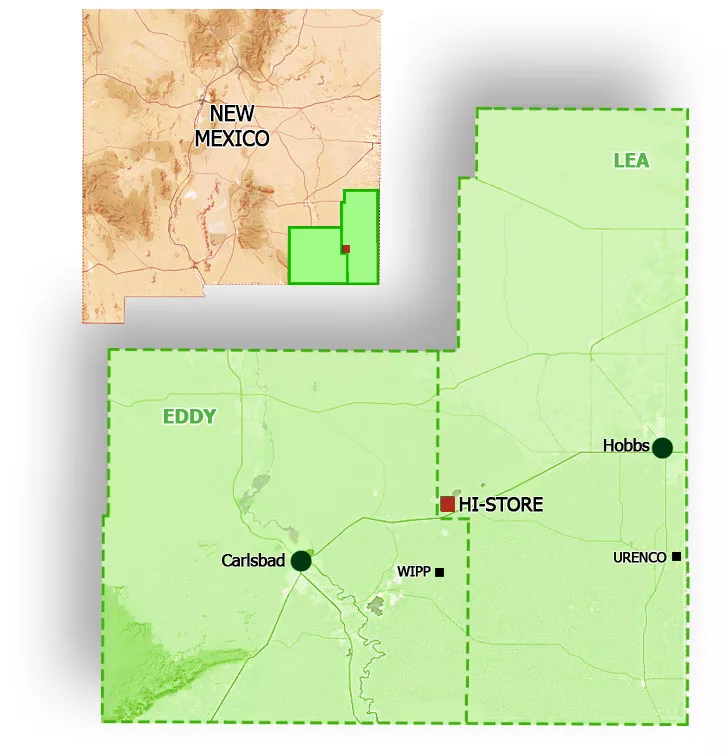
Named the HI-STORE CISF, the facility would have stored up to 10,000 canisters of commercial SNF on land owned by the Eddy-Lea Energy Alliance (ELEA) near the towns of Carlsbad and Hobbs.
“After discussions with our longtime partner in the HI-STORE project, the Eddy-Lea Energy Alliance, and due to the untenable path forward for used fuel storage in New Mexico, we mutually agreed upon canceling the agreement. This allows for ELEA to work to redevelop the property in a manner that fits their needs and allows Holtec to work with other states who are amenable to used fuel storage based on the recent DOE work on public education and outreach,” Holtec said in a statement (emphasis added).
Following the U.S. Supreme Court’s June ruling in NRC v. Texas, which found that petitioners did not have standing to challenge the Nuclear Regulatory Commission’s licensing of Interim Storage Partners’ CISF in Texas, Holtec said it expected to have its HI-STORE CISF license reinstated, allowing the company to move forward with the project. Holtec and ISP’s NRC licenses were vacated by the 5th Circuit Court of Appeals in a 2023 ruling.
Despite the court’s decision, New Mexico Gov. Michelle Lujan Grisham said she remained committed to preventing the HI-STORE CISF from being built. In 2023, New Mexico passed a bill barring the storage and disposal of high-level radioactive waste in New Mexico without the state’s explicit consent.
The AI Doomsday Machine Is Closer to Reality Than You Think
“Most troubling to experts on AI and nuclear weapons is that it’s getting harder and harder to keep decisions about targeting and escalation for nuclear weapons separate from decisions about conventional weapons.”
“There is no standing guidance, as far as we can tell, inside the Pentagon on whether and how AI should or should not be integrated into nuclear command and control and communications,” says Jon Wolfsthal, director of global risk at the Federation of American Scientists.
By Michael Hirsh | September 2, 2025 politico.com
Jacquelyn Schneider saw a disturbing pattern, and she didn’t know what to make of it.
Last year Schneider, director of the Hoover Wargaming and Crisis Simulation Initiative at Stanford University, began experimenting with war games that gave the latest generation of artificial intelligence the role of strategic decision-makers. In the games, five off-the-shelf large language models or LLMs — OpenAI’s GPT-3.5, GPT-4, and GPT-4-Base; Anthropic’s Claude 2; and Meta’s Llama-2 Chat — were confronted with fictional crisis situations that resembled Russia’s invasion of Ukraine or China’s threat to Taiwan.
Director Kathryn Bigelow is Sounding the Nuclear Alarm – Washington Post New Review
“A House of Dynamite” asks: How would the White House respond in the face of a nuclear attack?
By Max Boot | October 2, 2025 washingtonpost.com
VIEW MORE: “A House Of Dynamite” Q&A w/ Director Kathryn Bigelow, Tracy Letts, Jared Harris, And More At New York Film Fest —
80th Commemorations of Ban the Bomb – Trinity, Hiroshima & Nagasaki Remembrances in New Mexico
Exchange Monitor: DNFSB makes agency fixes, but needs members, GAO finds
The Defense Nuclear Facilities Safety Board (DNFSB) has tackled all but a few third-party recommendations to improve its culture over the past decade but suffers from a depleted board, according to a new report.
By ExchangeMonitor | September 5, 2025 santafenewmexican.com
Progress is tough with the five-person board probably…
China Hardens Military Stance Against U.S. With Nuclear Weapons and Tough Talk
Xi positions Beijing as powerful center of new global order as security forum convenes in capital
By Brian Spegele | September 18, 2025 wsj.com
BEIJING—China played down its rapidly rising military might for years. In the past few weeks, Beijing has broadcast a steady drumbeat of firepower displays and muscular rhetoric, carrying an unmistakable warning for the U.S….
Saudi Arabia signs a mutual defense pact with nuclear-armed Pakistan after Israel’s attack on Qatar
While not specifically discussing the bomb, the agreement states “any aggression against either country shall be considered an aggression against both,” according to statements issued by both Pakistan’s Foreign Affairs Ministry and the state-run Saudi Press Agency.
By MUNIR AHMED and JON GAMBRELL | September 18, 2025 apnews.com
ISLAMABAD (AP) — Saudi Arabia and nuclear-armed Pakistan have signed a mutual defense pact that defines any attack on either nation as an attack on both — a key accord in the wake of Israel’s strike on Qatar last week.
The kingdom has long had close economic, religious and security ties to Pakistan, including reportedly providing funding for Islamabad’s nuclear weapons program as it developed. Analysts — and Pakistani diplomats in at least one case — have suggested over the years that Saudi Arabia could be included under Islamabad’s nuclear umbrella, particularly as tensions have risen over Iran’s atomic program.
COMMUNITIES FOR CLEAN WATER: LANL Radioactive Tritium Venting Fails to Provide Transparency, Assurance, and Respect for Local Communities
FOR IMMEDIATE RELEASE: September 18, 2025
Santa Fe, NM — As NNSA and LANL continue operations to depressurize Flanged Tritium Waste Containers, Communities for Clean Water (CCW) calls out federal agencies for issuing vague assurances instead of transparent, verifiable data — and for dismissing community concerns with contradictory and incomplete statements that disregard what independent experts have found, the Department of Energy’s (DOE) own legal obligations, and the New Mexico Environment Department’s (NMED) acknowledgment that LANL has a long record of compliance failures.
“How can our communities be expected to trust LANL when they won’t give us access to the raw, real-time monitoring data – independently verified by the EPA,” asks Joni Arends with Concerned Citizens for Nuclear Safety. “Without this transparency, LANL is continuing a legacy of empty assurances, not accountability.”
Key Concerns:
-
Lack of real-time transparency – Since Friday (Sept. 12), the public has been forced to rely on NMED’s Facebook page for piecemeal updates. While LANL’s website provides very brief daily summaries, no near-real-time monitoring dashboard from DOE, NNSA, or LANL has been made available.
-
Vague assurances, not real information – NNSA’s updates claim “no tritium was released” while simultaneously telling the public to expect “very low levels of tritium” for subsequent venting. Without numbers, monitoring data, or detection thresholds, these phrases do not provide reassurance.
-
Weather risks – LANL has not disclosed thresholds for wind, rain, or humidity that would postpone venting. Communities watch weather shifts in real time but are left in the dark about how safety decisions are being made.
-
Dismissal of public health concerns – When asked for plain-language guidance that NMED stated LANL would provide, LANL responded only with “no offsite impact anticipated.” This is not meaningful and reassuring guidance, it’s a blanket dismissal that disregards independent expert findings and fails to meet DOE’s obligations to protect vulnerable populations.
-
Ignoring daily lifeways – Avoiding Pueblo Feast Days is not enough. This is harvest season, when outdoor cultural events, youth programs, and farming are in full swing. LANL’s scheduling continues to disregard these realities.
Unanswered Questions
Independent experts and community advocates have raised critical unanswered questions:
-
Unclear “depressurization” – LANL said “no internal pressure was found” in a container, but also claimed it was “depressurized.” If no pressure existed, what was released?
-
Unanswered helium questions – NMED stated helium was released, but LANL has not explained its origin. Was it introduced at sealing of the outer container, or a decay product of tritium?
-
Monitoring limits undisclosed – LANL has not disclosed the detection limits of its monitoring equipment. Readings “indistinguishable from zero” could still mask releases.
DOE NNSA Gives Misleading Statements on Native America Calling
On a recent Native America Calling program, DOE NNSA’s Los Alamos Field Office Deputy Director Pat Moss compared LANL venting to global natural tritium stocks. Independent expert Dr. Arjun Makhijani pointed out this comparison as misleading: “The problem is not global background, but local contamination. If venting occurs in rain and calm winds, local rainfall could exceed U.S. drinking water standards by hundreds to thousands of times.”
In their most recent public meeting, LANL admitted that infants could receive three times the radiation dose as adults. During the interview, Dr. Makhijani pressed this point – if adults are modeled at 6 mrem, that means infants could be at 18 mrem, nearly double the EPA’s 10 mrem compliance limit. Instead of addressing this directly, Mr. Moss provided a stock line, “We will be compliant with the regulatorily imposed release threshold and will be doing the calculations per the regulation.”
That is exactly the problem – hiding behind regulatory caps while ignoring clear evidence that infants, our most vulnerable, face exposures above legal limits.
DOE NNSA also pointed to the Defense Nuclear Facilities Safety Board (DNFSB) – an independent federal oversight body created by Congress – as if it had declared the tritium venting operation as “fully protective of the public”. That is misleading. First, the DNFSB has been operating without a quorum for months, limiting its ability to issue independent recommendations. Second, what the Board staff said in its July 2025 presentation was that the overall nuclear safety risk to the public is low if DOE’s proposed controls are followed. The DNFSB has also flagged ongoing safety concerns at LANL including deficiencies in Area G’s safety analysis and risk to workers.
First of four containers of tritium waste at LANL has been vented
The first of four flanged tritium waste containers awaiting removal from Los Alamos National Laboratory has been vented, the New Mexico Environment Department announced Tuesday afternoon.
By Alaina Mencinger amencinger@sfnewmexican.com | September 16, 2025 santafenewmexican.com
The container can now be moved for treatment at LANL and then, eventually, to an off-site disposal area.
No internal pressure was found in the first container, according to the National Nuclear Security Administration, suggesting the inner containers in the flanged tritium waste container hadn’t leaked. Air monitoring did not show an increase of tritium beyond background levels, the federal agency wrote.
No tritium emissions were released, the Environment Department wrote in its Tuesday post on X, formerly Twitter. Both the state agency and the U.S. Environmental Protection Agency are monitoring the process.
The depressurization of the containers is set to continue at 7 a.m. Wednesday, although the NNSA noted the schedule is subject to change due to weather. The four containers will be vented one at a time over an estimated two-week period.
*The featured image differs from the article photo due to usage rights.
New Mexicans Can Save the DNFSB; Contact Our Senators Today
From our friends at Concerned Citizens for Nuclear Safety:
The independent Defense Nuclear Facilities Safety Board has been dwindling from a five-member board to one member and may disappear if we, the People, do not raise our voices to support its essential nuclear safety work. The Safety Board needs at least two new members. And that needs to get done by Saturday, October 18th. https://www.dnfsb.gov/about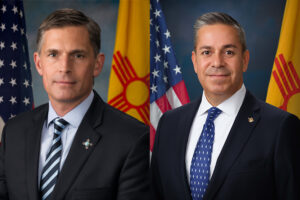
New Mexico U.S. Senators Heinrich and Lujan have key roles to play to ensure the Safety Board’s work continues unimpeded. https://www.heinrich.senate.gov/ and https://www.lujan.senate.gov/ Our voices of support are essential to ensure communities continue to receive the essential services of the Safety Board and its staff.
Right now members of the Safety Board’s staff are monitoring the venting of radioactive tritium from Area G at Los Alamos National Laboratory (LANL). Their expertise in the field of nuclear safety and their demonstrated competence and knowledge relevant to their independent investigative and oversight functions are an essential part of the process. They will be part of the follow-up once the venting of the four flanged tritium waste containers is completed. https://tewawomenunited.org/?s=tritium, https://www.ccwnewmexico.org/tritium, https://nuclearactive.org/
Not only does the Safety Board have staff at LANL, but also at Sandia National Laboratories in Albuquerque and at the Waste Isolation Pilot Plant, the burial site for plutonium contaminated nuclear weapons waste, near Carlsbad. https://ananuclear.org/facilities/
Russia suspected of helping North Korea build nuclear submarines, Seoul investigating
Analysts said such a technology transfer was plausible given Pyongyang’s support for Russia’s ongoing war in Ukraine
By Park Chan-kyong | September 18, 2025 scmp.com
South Korea is investigating reports that Russia has supplied North Korea with nuclear submarine reactor modules, a move analysts see as highly plausible and one that could mark a breakthrough in Pyongyang’s decades-long push for a nuclear powered navy…
Holy See tells nations at UN to end threat of nuclear weapons, even as deterrence
Amid a global arms race, ending the threat of nuclear war — and even the testing of nuclear weapons — is imperative, said the Holy See’s diplomat to the United Nations.
By Gina Christian, OSV News | September 8, 2025 catholicreview.org
Archbishop Gabriele G. Caccia, the Holy See’s U.N. permanent observer, shared his thoughts in a statement he delivered Sept. 4 at U.N. headquarters in New York, during the General Assembly High-level Plenary Meeting to Commemorate and Promote the International Day Against Nuclear Tests, observed that same day.
“The pursuit of a world free of nuclear weapons is not only a matter of strategic and vital necessity, but also a profound moral responsibility,” Archbishop Caccia in his remarks.
He pointed to the introduction of nuclear weapons — first detonated by the U.S. in 1945 over the Japanese cities of Hiroshima and Nagasaki, killing an estimated 110,000 to 210,000 people, during World War II — as unveiling to the world “an unprecedented destructive force.”
Historic peace vigil partially dismantled after Trump orders: ‘Take it down’
Law enforcement officials on Sunday removed parts of the White House Peace Vigil, which has sat just outside the White House for decades.
By Marissa J. Lang, The Washington Post | September 8, 2025 washingtonpost.com
But over the past week, it faced a new threat as Trump turned his attention to the vigil and federal officers picked apart the structure that shields protesters and their signs from the elements. The vigil is maintained by a rotating cast of volunteers who keep the protest going 24 hours a day, seven days a week.
On Friday, Brian Glenn, a correspondent for the conservative network Real America’s Voice, told the president during a gathering with reporters that there was “a blue tent” in front of the White House that was “an eyesore.” Trump initially said he was unaware of it, but he then quickly ordered its removal.
Photo by Sig. Chiocciola, Creative Commons: The White House Peace Vigil on March 30, 2025 staffed by volunteers, Philipos Melaku-Bello (left) and Joe Brown (right).
For 80 years, nuclear weapons have been the unused threat
Amid a global arms race, ending the threat of nuclear war — and even the testing of nuclear weapons — is imperative, said the Holy See’s diplomat to the United Nations.
By Matt Kelly, mkelly@virginia.edu, September 3, 2025 news.virginia.edu
In the 80 years since World War II, which ended with the use of two atomic bombs, the world has maintained a tenuous relationship with nuclear weapons.
Philip Potter, professor of public policy at the University of Virginia’s Frank Batten School of Leadership and Public Policy and director of the National Security Data and Policy Institute, said he worries about the current delicate nuclear balance.
“Eighty years of non-use is the product of both good diplomacy and a recognition of the potential consequences,” Potter said. “The fearsome power of nuclear weapons causes countries pause before they use them, but a great deal of work has also gone into nonproliferation and the management of crises to keep them away from the nuclear brink. In some ways the dynamics of the Cold War made managing the potential for nuclear confrontation easier.”
It’s a very different strategic scenario now, where there are nine nuclear powers and less capacity to manage them.
A House of Dynamite review – Kathryn Bigelow’s nuclear endgame thriller is a terrifying, white-knuckle comeback
★★★★★: Amid a global arms race, ending the threat of nuclear war — and even the testing of nuclear weapons — is imperative, said the Holy See’s diplomat to the United Nations.
By Peter Bradshaw, The Guardian | September 2, 2025 theguardian.com
Kathryn Bigelow has reopened the subject that we all tacitly agree not to discuss or imagine, in the movies or anywhere else: the subject of an actual nuclear strike. It’s the subject which tests narrative forms and thinkability levels.
Maybe this is why we prefer to see it as something for absurdism and satire – a way of not staring into the sun – to remember Kubrick’s (brilliant) black comedy Dr Strangelove, with no fighting in the war room etc, rather than Lumet’s deadly serious Fail Safe.
Nuclear News Archive – 2022
“STALKING CHERNOBYL” Q&A EVENT ON APRIL 26
On Sunday, 26 April 2020 the UN-designated International Chernobyl Disaster Remembrance Day, “Stalking Chernobyl” director Iara Lee hosted a live online Q&A session moderated by Jodie Evans, CODEPINK founder, with:
• Cindy Folkers, Radiation & Health Specialist from Beyond Nuclear International
• Sergii Mirnyi, scientist/tour operator from Chernobyl Tours
• Vitaly Servetnik from Friends of the Earth/Russian Socio-Ecological Union
• “Stalking Chernobyl” editor Dimo Petkov, cameraman Anton Fedorrko, co-producer Oleg Shalashov
• Dominik Orfanus, Yurij Syrcek, and Igor Pasko from the ; Chernobyl Welcome Tour Company
• Vladislav Voznjuck from the stalker/tour group DiggTour
• Lucas Brunelle, extreme cyclist and creator of ” Lucas Brunelle Goes To Chernobyl”
The discussion was livestreamed to Cultures of Resistance’s Facebook page at https://www.facebook.com/CulturesOfResistance/ and YouTube channel at https://www.youtube.com/user/CulturesofResistance
North Korea is advancing its nuclear program and increasing illicit trade, new UN report says
North Korea is advancing its nuclear program and increasing illicit trade in new and more opaque ways, according to a 267-page U.N. report that provides surveillance photos and new evidence.
The annual report, produced by sanctions monitors called the “Panel of Experts,” is a product of the U.N. Security Council. The purpose of the report is to offer recommendations on how to hold North Korea accountable for skirting restrictions imposed by U.N. sanctions since 2006, that are designed to curtail the nation’s nuclear weapons program.
New Mexico’s U.S. senators request more time for comment on LANL pit production
A letter from 120 activist groups and citizens has prompted the state’s two U.S. senators to ask federal agencies to give the public more time to comment on possible environmental effects of pit production at Los Alamos Laboratory.
ARTICLE BY: SCOTT WYLAND | santafenewmexican.com
U.S. Sens. Tom Udall and Martin Heinrich wrote to the National Nuclear Security Administration on Wednesday, urging it to extend the public comment period to June 19 on its environmental study of the lab’s future production.
They cited challenges presented by the COVID-19 crisis and referred to a letter they received from activists who had asked for the June 19 extension.
“We continue to believe that providing the public ample opportunity to comment on environmental documents … provides an invaluable source of expertise to NNSA’s decision-makers, enhances transparency and ensures accountability,” the senators wrote. “We respectfully request that you give careful consideration to extending the public comment period.”
60+ Orgs to Congress: No More COVID-19 Money For the Pentagon
 commondreams.com WASHINGTON – Congressional leadership must ensure that future COVID-19 response bills do not include any additional funds for the Pentagon, 61 organizations representing pro-diplomacy, veteran, faith, environmental, and anti-war communities, and more, from across the country, said in a letter today.
commondreams.com WASHINGTON – Congressional leadership must ensure that future COVID-19 response bills do not include any additional funds for the Pentagon, 61 organizations representing pro-diplomacy, veteran, faith, environmental, and anti-war communities, and more, from across the country, said in a letter today.
The letter, led by Win Without War, states that the Pentagon’s $756 billion budget provides more than enough resources to respond to the crisis caused by the pandemic. While there may be a limited role for the Pentagon in responding to the crisis — by, for example, aiding with construction of hospitals — the letter’s signers agree that these activities should be funded by the already-oversized Pentagon budget.
Letter to NNSA from NM Senators Udall & Heinrich Calling for Extended Comment Period on Expanded Plutonium Pit Production
[embeddoc url=”https://nukewatch.org/wp-content/uploads/2020/04/Senators-letter-to-NNSA-4-22.pdf” download=”all” viewer=”google”]
There’s a new world super-villain (COVID-19), it’s time for nuclear disarmament
Dingiswayo Mokoena | diggers.news
North Korean leader Kim Jong Un, second from right, inspects the preparation of the launch of a Hwasong-14 intercontinental ballistic missile (ICBM) in North Korea’s northwest. (Korean Central News Agency/Korea News Service via AP, File)THE Associated Press (AP) this week reported that a barrage of North Korean missiles fired from both the ground and fighter jets splashed down on the waters off the peninsular’s east coast on Tuesday. AP further reports that North Korea also launched several Sukhoi-class fighter jets that fired an unspecified number of air-to-surface missiles toward the North’s eastern waters. According to a South Korean defence official, North Korea seems to be resuming its military drills that it had scaled back due to concerns about the coronavirus pandemic. This, consequently, pushing back the deadlocked denuclearisation negotiations fostered by the United Nations.
How the Military-Industrial Complex Is Using the Coronavirus
Arms industry lobbyists are addressing this pandemic and preparing for the next by pushing weapons sales.
ARTICLE BY: SCOTT WYLAND | santafenewmexican.com
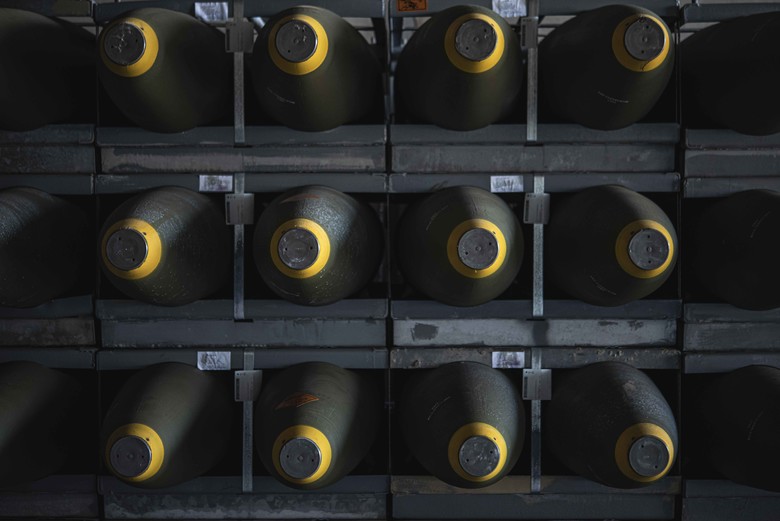
There’s a battle brewing for the future of national security spending.
On one side, there’s a growing bipartisan consensus that the coronavirus has fundamentally changed the way we should think about national security. Ben Rhodes, former deputy national security adviser in the Obama White House, recently argued in The Atlantic that we have to rethink the orientation and priorities of our government, and “it makes no sense that the Pentagon budget is 13 times larger than the entire international-affairs budget, which funds the State Department, USAID, and global programs at other agencies.”
Kori Schake, the director of foreign and defense policy studies at the conservative American Enterprise Institute, said the bottom line is that “we’re going to see enormous downward pressure on defense spending because of other urgent American national needs like health care.”
SFCC, Los Alamos lab join to offer machinist program
BY DILLION MULLIN | santafenewmexican.com
Santa Fe Community College and Los Alamos National Laboratory announced last week a new collaboration to revamp the college’s machinist program.
With the campus providing the latest equipment and curriculum and the lab offering hands-on internships, community college President Becky Rowley said she hopes the first group of students can begin working toward a certificate or associate’s degree in the overhauled program this fall.
Congress Should Hit Pause On The New Intercontinental Ballistic Missile
Within just a few years, the estimated cost of GBSD skyrocketed from $62 billion to $85 billion to $150 billion, and is now likely to be even higher.
ARTICLE BY: MATT KORDA | forbes.com
Although the COVID-19 pandemic has caused daily life to grind to a halt, it has had little effect on the military-industrial complex––which, incredibly, appears to be speeding up.
Late last week, the Air Force revealed that it was considering awarding one of its most important contracts––the massive Engineering and Manufacturing Development contract for the next generation of intercontinental ballistic missiles––even earlier than expected, in an attempt to lock the program in as soon as possible.
This news comes only two months after the release of the President’s FY21 budget request, which also raised eyebrows given the dramatic increase to the nuclear weapons budget––and particularly, the tripling of the ICBM budget.
Stalking Chernobyl
Chernobyl is a place of loss and abandonment. The Zone is radioactive. So why do people flock there today? Iara Lee’s fascinating documentary goes with them to find out, and reminds us about life there before the April 26, 1986 nuclear disaster.
ARTICLE BY: LINDA PENTZ GUNTER | beyondnuclear.org
For most of us, Pripyat — the Ukrainian city that has become an iconic symbol of forced abandonment — summons images of drab, Soviet decay. Pripyat is a place of ghastly tower blocks, rusting playgrounds, a deserted Ferris wheel and peeling paint, its workforce trudging like automata to toil at the doomed Chernobyl nuclear power plant just 2.5km away.
But in the opening sequence of Iara Lee’s new documentary — Stalking Chernobyl; exploration after the apocalypse — we see a very different Pripyat, before the April 26, 1986 nuclear disaster. It is a place of singing and roses, swimming pools and picnics, and dancing babushkas.
And then, as someone in the film says, “On April 26, what had once been our pride became our grief.”
The Women Who Told Chernobyl’s Story – And the Charity that Sees Those Consequences First Hand
Three great women writers have done so much to tell the story of Chernobyl. Their focus was not on the accident itself, but its impact on the people of Belarus and Ukraine.
ARTICLE BY: LINDA WALKER | beyondnuclear.org
Alla Yaroshinskaya
When reactor No 4 at the Chernobyl Nuclear Power Plant blew up in the early hours of 26th April 1986, it threw millions of curies of radioactive materials into the air, forming a 2km high plume.
Amongst the most dangerous isotopes it released were iodine 131, caesium 137 and strontium 90.
But according to Alla Yaroshinskaya, a journalist whose tenacity was responsible for revealing much of the subsequent cover-up, the most dangerous substance to escape from the mouth of the reactor did not appear on the periodic table. It was Lie-86, a lie as global as the disaster itself.
Continue reading
Northrop could get $85 billion award to make next-gen ICBMs sooner than expected
Within just a few years, the estimated cost of GBSD skyrocketed from $62 billion to $85 billion to $150 billion, and is now likely to be even higher.
ARTICLE BY: VALERIE INSINNA| defensenews.com
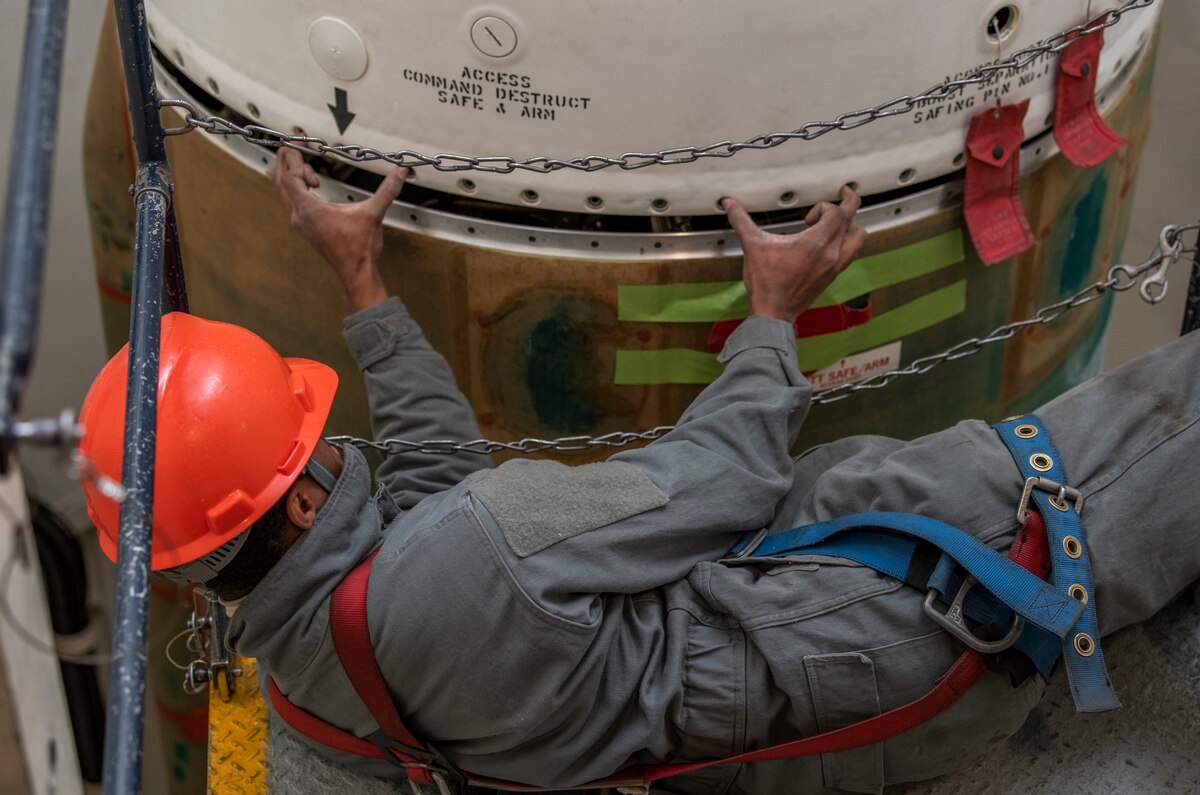
WASHINGTON — An award for the U.S. Air Force’s Ground Based Strategic Deterrent program is slated to be granted by the end of September, but it could happen earlier, the service’s acquisition executive said Thursday.
“I think early award is possible on GBSD,” Will Roper told reporters during a teleconference. “I’m very hopeful, but because GBSD has a large component of classified work, that team is having to go in and maintain workforce in our [sensitive compartmented information facilities] and in our classified spaces. So we’re watching very carefully to make sure the installations are open to allow that work.”
As the sole bidder on the GBSD program, Northrop Grumman is anticipated to win an estimated $85 billion to design and build the Air Force’s next-generation intercontinental ballistic missiles.
Spent Nuclear Fuel from Germany to SRS? Dumping-for-Profit Scheme Drags On & On & Should be Terminated
FOIA Documents Confirm Profiteers Still Pursuing Scheme to Dump Highly Radioactive German Spent Fuel (Graphite “Pebbles”) at SRS – Should be Terminated
SRS and the German entity Jülicher Entsorgungsgesellschaft für Nuklearanlagen (JEN) are still working on the scheme to import German highly radioactive graphite spent fuel from the Jülich, Germany storage site to SRS for reprocessing and dumping. That this bad idea to import the nuclear waste in large CASTOR casks is continuing has been confirmed in documents obtained by SRS Watch in response to a Freedom of Information Act (FOIA) request received on April 7, 2020.
SRS Watch first alerted the public in 2013 – at a SRS Citizens Advisory Board meeting – that the US-Germany waste deal was at hand, forcing SRS to admit that was indeed the case. Pursuit of he deal has been dragging on since 2012.
Continue reading
How nuclear forces worldwide are dealing with the coronavirus pandemic
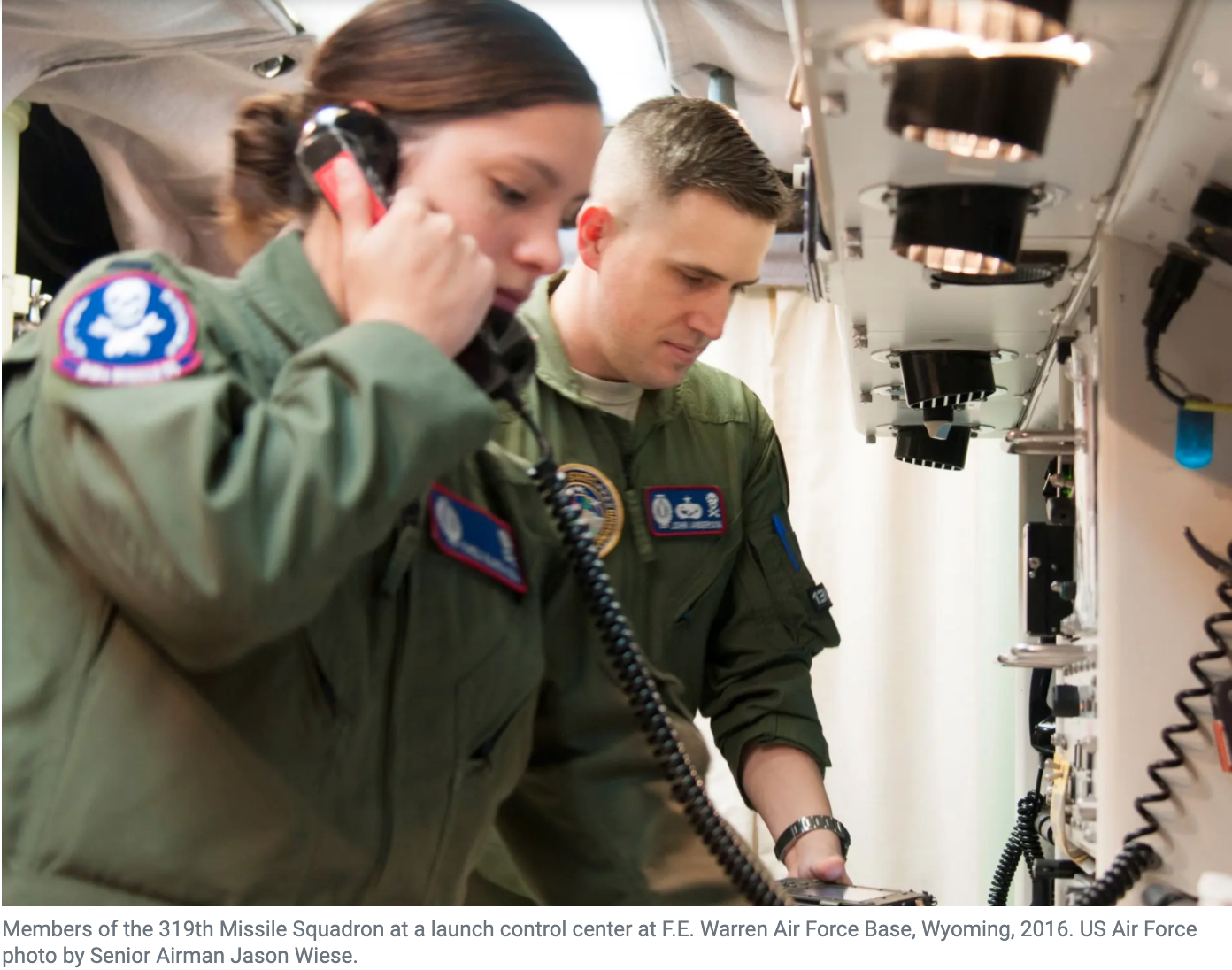
In recent weeks, the coronavirus outbreak has elicited at least a few tone-deaf comments from top US defense officials about the readiness of their nuclear forces. In mid-March, the commander of US Strategic Command, Adm. Charles Richard, reassured his audience that the United States’ nuclear forces had not been adversely affected by the pandemic and that they “remain ready to execute the nation’s strategic deterrence mission.” In effect, Adm. Richard was telling his audience that the United States was still capable of launching a massive nuclear retaliation that would undoubtedly kill millions. Similarly, at the beginning of April, the commander of the US Air Force’s Global Strike Command told Popular Mechanics that, despite the COVID-19 outbreak, “its nukes are still ready to fly.” These officials were apparently oblivious to the notion that, with the pandemic already causing enough fear and dread on its own, now may not be the best time to remind the general public about other ways the world could end.
What the United States loses by quitting the Open Skies treaty, in one chart
Reports emerged this week that the White House may be moving “soon” on withdrawing from the Open Skies treaty, a nearly two-decade-old agreement that allows 34 countries to fly and share reconnaissance missions over each other to promote military cooperation and transparency.
Last month, defense secretary Mark Esper said he was freezing a long-overdue replacement of the aging OC-135B aircraft used for flights under the treaty. “Until we make a final decision on the path forward, I am not prepared to recapitalize aircraft,” Esper told the Senate Armed Services Committee. Although more than 1,500 observation flights have been flown since the treaty took effect in 2002, vocal Republican opponents like Sens. Tom Cotton, Richard Burr, and Ted Cruz claim its benefit is “marginal” because US satellites make aerial imagery unnecessary, and the United States gives up more to its adversaries under the treaty than it gains. Their criticism extends from complaints about the costs of the OC-135B upgrade to protests over Russian compliance with the treaty—specifically, restrictions on missions flown over Kaliningrad and along Russia’s border with Abkhazia and South Ossetia. Cotton and Cruz introduced a resolution calling for withdrawal in October.
NNSA Production Sites Hunker Down Amid COVID-19 Crisis
All but one of the main Department of Energy nuclear weapons production sites have now hunkered down into minimum mission-critical operations because of COVID-19, keeping only the personnel needed to assemble nuclear weapons and components, maintain key infrastructure, or provide security.
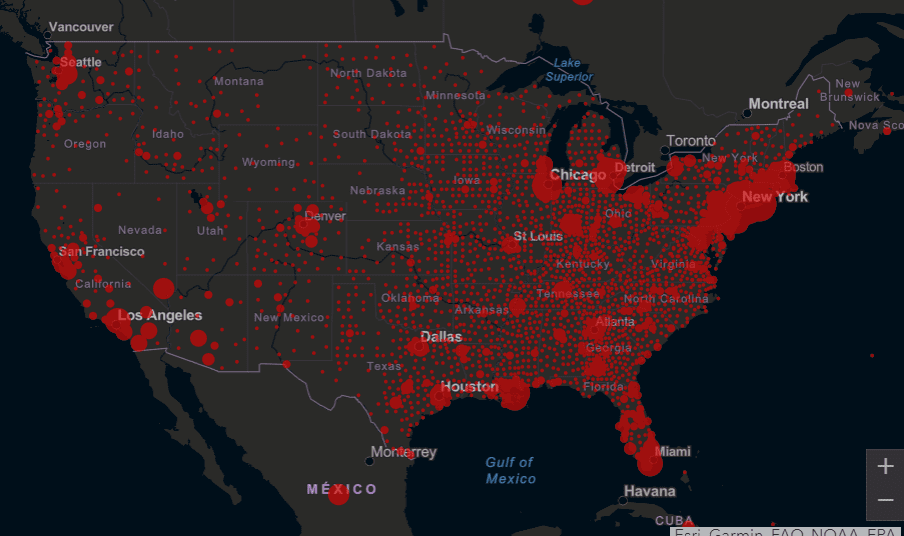
The Pantex Plant in Amarillo, Texas, and the Y-12 National Security Complex in Oak Ridge, Tenn., both announced the switch to minimum mission-critical operations this week, joining the Savannah River Site of Aiken, S.C., which adopted a similar posture late last month.
Only the Kansas City National Security Campus, which sits in the middle of a far worse outbreak than Pantex, Y-12, and Savannah River combined, had not gone down to the minimum mission-critical level of operations. The plant, which makes the non-nuclear parts of nuclear weapons, has reduced the number of people onsite since the outbreak and confirmed its first case of COVID-19 this week, saying Friday an employee “recently tested positive.”
The Coronavirus Can’t Stop America’s Nukes
Relying on a high-state of readiness, the nuclear triad is under threat from the coronavirus. But the head of Global Strike Command tells Popular Mechanics that its nukes are still ready to fly.
As the world fights against the COVID-19 pandemic, nuclear weapons have taken a backseat in most people’s minds. But for Global Strike Command (AFGSC)—the Air Force unit in control of two of the three legs of America’s nuclear triad—their mission remains top priority.
And it’s an unforgiving business. Nuclear deterrence requires extreme levels of readiness among pilots, maintenance crews, and security teams. Adversaries that don’t think the U.S. can respond with conventional bombing strikes or nukes could be emboldened to act aggressively.
OAK RIDGE ENVIRONMENTAL PEACE ALLIANCE CALLS FOR PUBLIC HEARING ON DOCUMENT ANALYZING HEIGHTENED EARTHQUAKE RISK AT NUCLEAR BOMB PLANT, ASKS FOR EXTENSION OF COMMENT PERIOD DUE TO PANDEMIC
The Oak Ridge Environmental Peace Alliance today filed a formal request with the Department of Energy and the National Nuclear Security Administration seeking an indefinite extension of the comment period and a public hearing on the NNSA’s study of earthquake and accident consequences at the Y-12 Nuclear Weapons Complex in Oak Ridge, Tennessee.
Citing a letter from twenty-two Senators that called for an indefinite extension of public comment periods until such time as the COVID-19 national state of emergency has ended, OREPA asked NNSA Administrator Lisa Gordon-Hagerty and Secretary of Energy Dan Brouilette to recognize the significant disruption in public and private life due to the COVID-19 pandemic and to respond appropriately.
After Decades of Secrets, Rocky Flats Should Still Give Pause
FOR MORE INFORMATION: The rockyflatsambushedgrandjury.com web site offers many Resource Materials in support of The Ambushed Grand Jury non-fiction and profit book about the Rocky Flats criminal investigation and Special Federal Grand Jury investigation, including pictures and videos.
Chernobyl fire: Huge forest blaze moves within one kilometre of abandoned nuclear plant
A forest fire that has raged in Ukraine for more than a week has spread to within a kilometre of the Chernobyl power plant, environmental campaigners have warned.
Footage of the region has shown fires raging through the 30km exclusion zone set up around the site of the worst nuclear disaster in history, with black smoke billowing into the sky as firefighters attempting to beat back the blaze from helicopters.
Lawmakers cry foul as Trump considers retreating from Open Skies Treaty
Supporters of a treaty meant to reduce the risk of accidental war are sounding the alarm President Trump could withdraw from the agreement as the world’s attention is consumed by the coronavirus pandemic.
BY REBECCA KHEEL | thehill.com
The Open Skies Treaty allows the pact’s 35 signatories, including the United States and Russia, to fly unarmed observation flights over each other’s territories with the intention of providing transparency about military activities to avoid miscalculations that could lead to war.
Administration officials insist a review is ongoing as four top Democrats warned this past week that withdrawing “in the midst of a global health crisis is not only shortsighted, but also unconscionable.”
“We are deeply troubled by the Trump administration’s sustained push to withdraw from the Open Skies Treaty and we reject the administration’s arguments for pursuing withdrawal,”
Continue reading
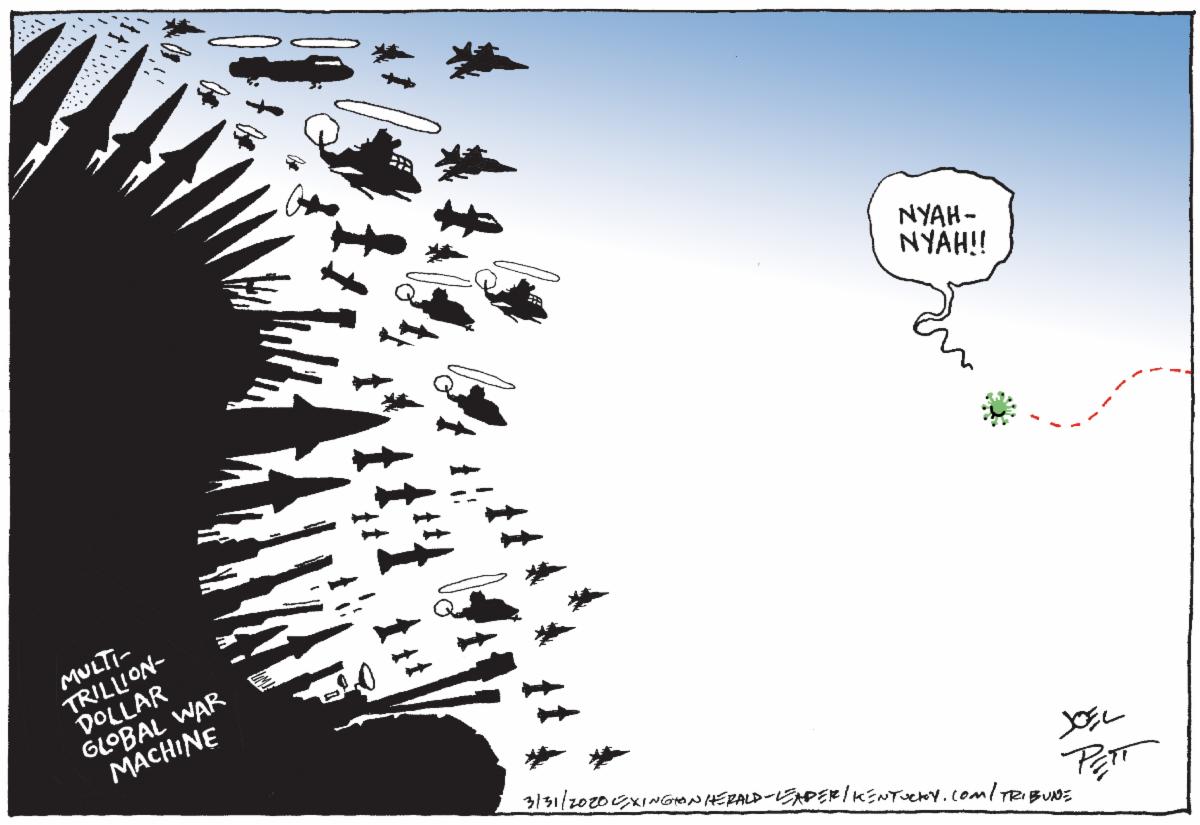
Researchers Find Plutonium Particles in Soil Near Rocky Flats
“Researchers from Northern Arizona University (NAU) found extensive plutonium “hot” particles in soil near the former Rocky Flats nuclear site. Particles this size can be inhaled and lodged in lung tissue, increasing risk of radioactive exposure from inhalation.”
ARTICLE BY: KEELY SUGDEN | kdvr.com
Rocky Flats National Wildlife RefugeDENVER (KDVR) – Researchers Michael Ketterer and Scott Szechenyi from (NAU) concluded, “These particles are found to be pervasive in non-US Government land east of Rocky Flats, and it is reasonable to believe that ongoing wind transport is continuing to spread the contamination across open space used by the public, and toward residential areas.”
Surface soil was collected from the Jefferson County right-of-way property immediately west of Indiana Street in 2019.
NEW OAK RIDGE EARTHQUAKE RISK ANALYSIS SAYS PUBLIC SAFETY RISK IS TEN TIMES GREATER THAN PREVIOUS ESTIMATES
OREPA CALLS FOR PUBLIC HEARING: “WE HAVE A RIGHT TO BE INFORMED AND CONSULTED ABOUT THE RISKS.”
The third time is proving far from charming for the government’s plan to continue making nuclear bomb parts in Oak Ridge. The National Nuclear Security Administration this week released its third Supplement Analysis [SA] for the Y-12 Nuclear Weapons Complex. Buried on page 31 of the report is the finding that the consequences of a worst-case scenario are ten times greater under the current plan than previously disclosed in the 2011 Site-Wide Environmental Impact Statement.
Air Force Wants to Add More Long-Range Bombers to its Inventory
“The Air Force has been looking to improve its fleet by purchasing the upcoming B-21 Raider and modernizing the Boeing B-52 Stratofortress.” The Air Force has classified the costs of the B21 heavy bomber. Among other armaments, it will carry theW80-4 Long Range Stand Off nuclear warhead.
ARTICLE BY: CONNIE LEE | nationaldefensemagazine.org
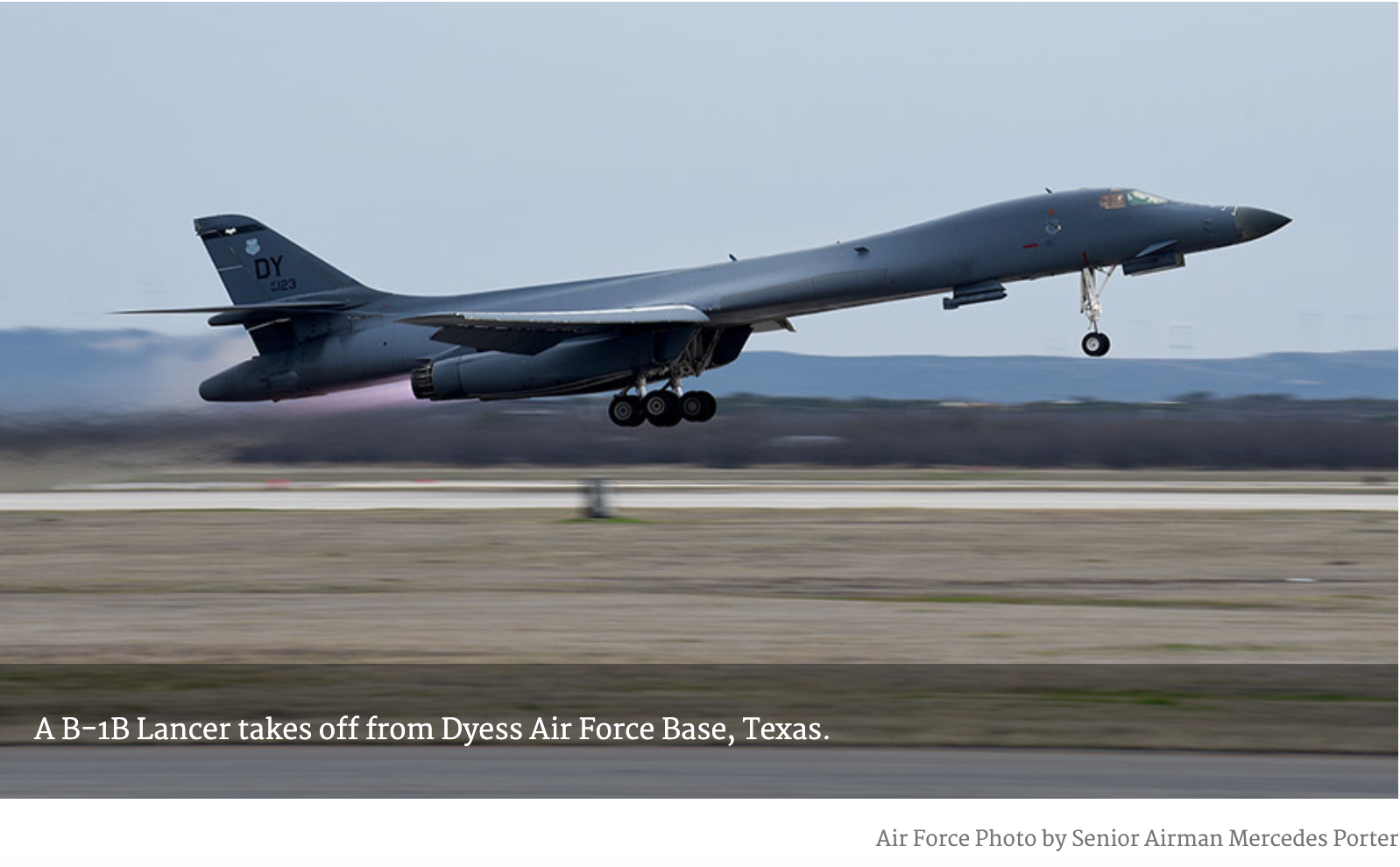
The Air Force wants “just north” of 220 long-range bombers in its inventory by 2040, a service official said April 9.
Previously, the service said it wanted 175 aircraft in the current fleet, but “that was a programmatically derived approach,” Gen. Timothy Ray, head of Air Force Global Strike Command, told reporters during a call with reporters.
Udall Leads Senate Democrats In Urging Trump Administration to Indefinitely Extend Public Comment Periods and Pause Unrelated Federal Rulemakings During COVID-19 Pandemic Emergency
Trump administration is continuing controversial rulemakings that affect public health and safety – while the COVID-19 pandemic prevents Americans from weighing in on national policymaking process and necessary Tribal consultation
WASHINGTON—Today, U.S. Senator Tom Udall (D-N.M.) and 21 Senate Democrats sent a letter to Acting Director of the U.S. Office of Management and Budget (OMB) Russell Vought, calling on the executive branch to protect Americans’ right to participate in the democratic policy-making process, at a time when millions are worried about their and their loved ones’ health, safety and economic security and are unable to fully participate in the public comment process.
The senators requested that OMB indefinitely extend existing public comment periods and hearings until the public can safely gather after the dangers of the COVID-19 pandemic have passed.
LANL postpones radioactive vapor release because of COVID-19
“We’re pleased that LANL is postponing its massive radioactive tritium release, particularly as northern New Mexico braces for the coronavirus pandemic,” Jay Coghlan, executive director of Nuclear Watch New Mexico, said in a statement. “But postponement is not the answer. Since tritium decays so rapidly into harmless helium the lab should simply sit on it instead of putting the population at risk.”
ARTICLE BY: SCOTT WYLAND | santafenewmexican.com
Los Alamos National Laboratory will indefinitely postpone a project that would release radioactive vapors into the atmosphere because staff needed for the task are working from home during the COVID-19 pandemic.
The lab had planned to ventilate four containers of tritium-tainted waste April 17 to relieve built-up radioactive hydrogen in the barrels’ headspace to prevent them from rupturing while they are being handled or shipped. The U.S. Environmental Protection Agency approved the application for the radioactive release last year.
Coronavirus pandemic could delay Pentagon spending, policy bill, HASC chairman says
Rep. Adam Smith says widespread testing will play a major role in getting people back to work
ARTICLE BY: COREY DICKSTEIN | STARS AND STRIPES stripes.com
WASHINGTON — The coronavirus pandemic could delay federal funding bills, including the annual Pentagon spending and policy law, if the outbreak continues to paralyze American life into the summer months, a top House lawmaker on defense issues said Tuesday.
Rep. Adam Smith, D-Wash., told reporters that House Armed Services Committee members and staffers were moving forward in an effort to ready drafts of the 2021 National Defense Authorization Act by May 1. But with no end in sight to the pandemic and with most lawmakers at their homes across the nation, he worries about the Sept. 30 deadline for an on-time bill.
Continue reading
Coronavirus response to take priority in NDAA, House Armed Services chairman says
Rep. Adam Smith says widespread testing will play a major role in getting people back to work
ARTICLE BY: ANDREW CLEVENGER | rollcall.com
Ramping up production of testing materials for COVID-19 will be a top priority for this year’s annual defense policy bill, the chairman of the House Armed Services Committee said Tuesday.
Widespread testing will play a major role in getting people back to work, Washington Democrat Adam Smith told reporters during a press call. And some components of testing, like swabs, are already in short supply.
The Defense Department, Smith said, has a lot of experience and expertise in logistics and contracting and could lead government efforts to ensure the availability of extensive testing.
The Nuns, The Priests, and The Bombs
Nuclear disarmament activists challenge the security and legality of America’s nuclear weapons when they break into two top-secret facilities: The “Fort Knox of Uranium” and a U.S. Navy Trident nuclear submarine base.
Are they criminals or prophets sending a wake-up call to the world?
Russia’s nuclear workers isolated onsite as coronavirus spreads
Workers at Russia’s nuclear power plants will be isolated from the general public and required to live in onsite clinics at their respective stations as nuclear authorities tighten their response to the coronavirus after a number of industry infections.
BY CHARLES DIGGS | bellona.org
The order came Tuesday from Rosenergoatom, Russia’s nuclear utility, and specified that both primary and back up crews of nuclear technicians, who “facilitate process continuity” would now be required check in to dispensaries at their plants, where they would be provided with daily living essentials and isolated from outside contact.
Cleanup of U.S. Nuclear Waste Takes Back Seat as Virus Spreads
“The coronavirus pandemic demonstrates why we should get cleanup done once and for all,” said Jay Coghlan, executive director of Nuclear Watch New Mexico. “What we do as humans ebbs and flows with history, but the radioactive and toxic wastes that we leave behind last longer than our recorded history. We should be acting now.”
ARTICLE BY: SUSAN MONTOYA BRIAN | santafenewmexican.com
The U.S. government’s efforts to clean up Cold War-era waste from nuclear research and bomb making at federal sites around the country has lumbered along for decades, often at a pace that watchdogs and other critics say threatens public health and the environment.
Now, fallout from the global coronavirus pandemic is resulting in more challenges as the nation’s only underground repository for nuclear waste finished ramping down operations Wednesday to keep workers safe.
Trump Administration Determined to Exit Treaty Reducing Risk of War
Mike Pompeo and Mark Esper agreed to proceed with US withdrawal of Open Skies Treaty despite pandemic, sources say
ARTICLE BY: JULIAN BORGER | theguardian.com
The Trump administration is determined to withdraw from a 28-year-old treaty intended to reduce the risk of an accidental war between the west and Russia by allowing reconnaissance flights over each other’s territory.
Despite the coronavirus pandemic, which has put off a full national security council (NSC) meeting on the Open Skies Treaty (OST), the secretary of defence, Mark Esper, and secretary of state, Mike Pompeo, have agreed to proceed with a US exit, according to two sources familiar with administration planning.
Gorbachev: Time to Revise the Entire Global Agenda
An Interview with Mikhail Gorbachev, World BEYOND War, April 5, 2020 | worldbeyondwar.org
Q: How did you take the news of the pandemic?
A: I think I took it the way most people did. Initially, there was hope that it could be controlled, localized. But things took a very different turn and the epidemic spread far and wide. Unprecedented measures and decisions became necessary. Leaders, citizens and international organizations found themselves in an extremely difficult situation. All of this will have to be thoroughly analyzed, but the priority now is to take things in hand and defeat this new, vicious enemy.
Advocates raise questions about proposal to allow some nuclear waste to be disposed in landfills
“I find it just astonishing that they would do that in the midst of the coronavirus pandemic. How the NRC can look themselves in the mirror to propose massive deregulation and do it in the midst of the pandemic, I find it just ethically shocking.” — Dan Hirsch, former director of the University of California, Santa Cruz’s Program on Environmental and Nuclear Policy
ARTICLE BY RACHEL FRAZIN | thehill.com
Scientists and advocates are raising concerns about a proposed relaxation on regulations for disposing of nuclear waste, saying that the government should halt the proposal as the scientific community focuses on the coronavirus.
A March 6 Nuclear Regulatory Commission (NRC) proposal would allow for the disposal of some nuclear waste in municipal landfills, rather than a licensed facility.
Advocates say the proposal could put public health at risk, pushing the NRC to give the public more time to weigh in.
NRC Proposes Allowing Nuclear Waste at Dumps, Recycling Sites
“Diane D’Arrigo, radioactive waste project director for the Nuclear Information and Resource Service, says the change would allow the industry to dispose of any waste other than irradiated fuel at landfills. That includes concrete, soil, clothing or any material where radiation still exists.”
ARTICLE FROM publicnewsservice.org
A federal rule change could allow waste disposal at locations other than radioactive-storage facilities. (Scanrail/Adobe Stock)BOISE, Idaho — The Nuclear Regulatory Commission may change its rules to allow the nuclear industry to dump some of its waste in landfills.
Opponents say the change poses a public health risk and would allow waste to go unmonitored.
The proposal would enable the NRC to reinterpret the meaning of low-level radioactive waste so that it could be accepted at dumps and hazardous waste sites, rather than regulated storage facilities.
Why should NM store nation’s nuclear waste?
ARTICLE BY: LAURA WATCHEMPINO | MULTICULTURAL ALLIANCE FOR A SAFE ENVIRONMENT, PUEBLO OF ACOMA
If the Nuclear Regulatory Commission’s conclusion that it’s safe to move spent nuclear fuel from nuclear power plants across the country to a proposed storage facility in Lea County sounds vanilla-coated, it’s because the draft environmental impact statement for a Consolidated Interim Storage Facility submitted by Holtec International did not address how the casks containing the spent fuel would be transported to New Mexico.
LANL Tritium Ventilation Project On Hold Due To COVID-19, Scope Of Work Amended To Include Possible Secondary Venting
ARTICLE BY: MAIRE O’NEILL | losalamosreporter.com
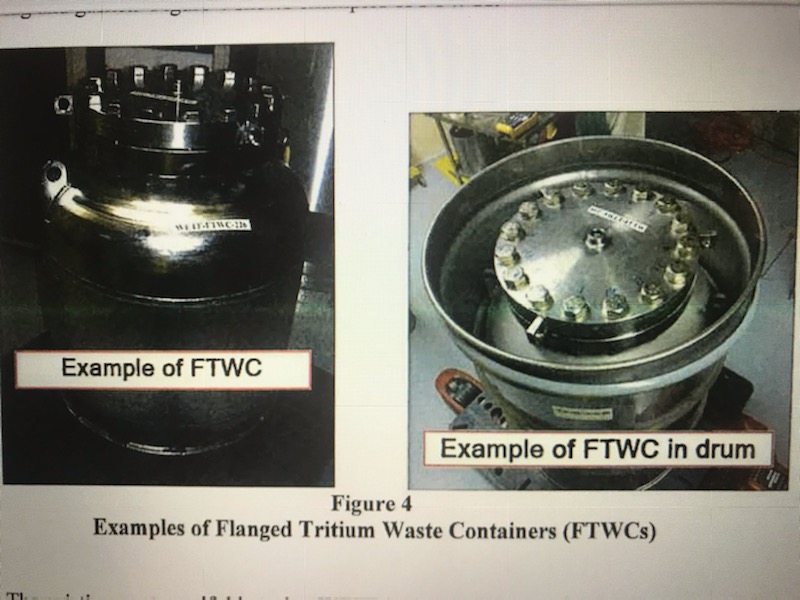
Los Alamos National Laboratory has notified the Environmental Protection Agency that plans for venting four flanged tritium waste containers (FTWCs) at Technical Area 54 have been finalized with an amended scope of work. However, according to NNSA Los Alamos Field Office spokesperson Toni Chiri, the operations, originally slated for this month, have been postponed due to COVID -19 and won’t be executed until the Laboratory is able to support the activity with a full complement of operational personnel.
Covid-19 is Killing Off Our Traditional Notions of National Defense
“It never made any sense, as Trump’s 2021 budget had initially proposed, to increase spending on nuclear weapons by $7 billion while cutting Centers for Disease Control and Prevention funding by $1.2 billion.”
I have always been a strong supporter of the U.S. armed forces, because I believe they are needed to safeguard our freedom and prosperity in a dangerous world. But even hawks like me cannot be blind to the prevalence of “black swan” events in the past 20 years.
Nuclear News Archives – 2021
Nothing Found
It seems we can’t find what you’re looking for. Perhaps searching can help.

